ala breve
The Official Publication of the Alabama Music Educators Association

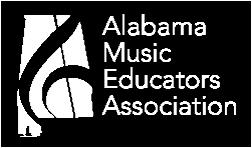
May/June 2024

. S

p e r f o r m e r s . T h e m u s i c d e p a r t m e n t o f f e r s i t s
m a j o r s a m p l e o p p o r t u n i t i e s t o d e v e l o p t h e i r
k n o w l e d g e a n d m u s i c a l s k i l l s t o b e c o m e
p r o f e s s i o n a l e d u c a t o r s a n d m u s i c i a n s K e y
c o u r s e s f o r a l l m u s i c m a j o r s a n d m i n o r s a r e
M u s i c H i s t o r y , M u s i c T h e o r y , M u s i c
T e c h n o l o g y , C o n d u c t i n g , A p p l i e d L e s s o n s ,
a n d E n s e m b l e s .

DEGREE PROGRAMS IN MUSIC
BACHELOR OF ARTS IN MUSIC
-Music Education with Instrumental or Vocal Concentration
-General Music with Instrumental or Vocal Concentration
-Performance with Instrumental, Vocal, Piano, or Jazz Concentration
MASTER OF ARTS IN MUSIC
-Instrumental Music Education
-Instrumental General Music V l M i Ed ti
MINORS
-Music
-Music Technology -Jazz Studies






May/June 2024
An Equal Opportunity | Affirmative Action Employer
T h e D a v i d L W a l t e r s D e p a r t m e n t o f M u s i c h a s o v e r 3 0 0 u n d e r g r a d u a t e a n d g r a d u a t e m u s i c
m a j o r s
t u d e n t s a r e l e d b y 4 0 f a c u l t y
h o a r e w o r l d - c l a s s t e a c h e r s ,
m e m b e r s w
s c h o l a r s , c o n d u c t o r s , c o m p o s e r s , a n d
AMEA Governing Board 2023-2024

Dr. Rob Lyda President Cary Woods Elementary School 715 Sanders Street Auburn, AL 36830 334-663-0898 president@myamea.org

Lori Hart President, Alabama Bandmasters Association Guntersville High School 14227 US 431 Guntersville, AL 35976 (334) 797-1778 aba_president@myamea.org

Matthew Suit President, Alabama cNAfME msuit@troy.edu

Dr. Phil Wilson President-Elect
Ogletree Elementary School 737 Ogletree Road Auburn, AL 36830 (334) 538-9679 president_elect@myamea.org

Joseph Lee President, Alabama Orchestra Association PO Box 2532 Huntsville, AL 35804 (615) 397-4490 aoa_president@myamea.org

Alicia Luttrell President, ELEM/GEN Old Shell Road School 3160 Heather St. Mobile, AL 36607 (251) 221-1557 aluttrell@mcpss.com

Dr. Meghan Merciers Alabama cNAfME Advisor University of North Alabama UNA Box 5040 142 Music Building Florence, AL 35632-0001 (256) 765-4518 mmerciers@una.edu

Joey Harbison Industry Representative Gadsden Music Company 607 Broad Street PO Box 132 Gadsden, AL 35901 205-910-2622 jmharbison@aol.com

Heather Holmes Recording Secretary Oak Mountain Middle School 5650 Cahaba Valley Rd Birmingham, AL 35242 205-682-5210 recording_secretary@myamea.org

Hilen Wilson President, Alabama Vocal Association 6315 Mary Harmon Bryant Drive Cottondale, AL 35453 (205) 454-3067 ava_president@myamea.org

Dr. Carly Johnson President, HED Division Alabama State University Department of Music 915 S. Jackson Street Montgomery, AL. 36104 (334) 229-4341 cjjohnson@alasu.edu

Andy Meadows Alabama Department of Education Arts Education Specialist 50 North Ripley Street Montgomery, Alabama 36104 (334) 694-4768 ameadows@ALSDE.edu

Dr. Russell (Rusty) Logan Executive Director 2020 Janabrooke Lane Auburn, AL 36830 (334) 663-1702 executive_director@myamea.org


David Raney Assistant Executive Director 25162 Hudson Bend Athens, AL 35613 (256) 651-8223
Pat Stegall Treasurer-Registrar AMEA Registration PO Box 3385 Muscle Shoals, AL 35662 (256) 627-4661 treasurer_registrar@myamea.org

Garry Taylor Editor, Ala Breve 1600 Manor Dr. NE Cullman, AL 35055 (256) 636-2754 editor@myamea.org
4 ala breve
Staff
Ala Breve is published four times a year (August, October, February & May) by the Alabama Music Educators Association and printed by Hardwick and Son Printing in Dothan, Alabama.
Bulk rate postage paid at Dothan, Alabama.
ADVERTISING & COPY DEADLINES
August/September
(Back to School issue): July 15
October/November (Conference issue): September 15
February.March (All-State issue:)
January 15
May/June (Summer issue:) April 15
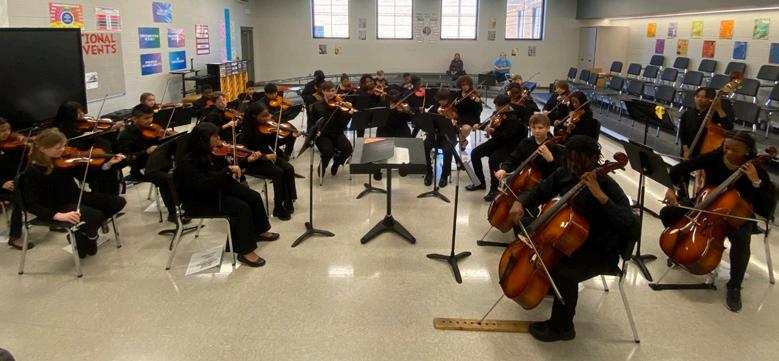
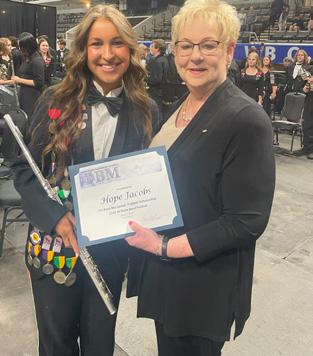


Unless otherwise indicated, permission is granted to NAfME members to reprint articles for educational purposes. Opinions expressed in this publication are not necessarily those of AMEA or the Editor. All announcements & submissions are subject to editorial judgement/revision.The Alabama Music Educators Association is a state unit of NAfME:
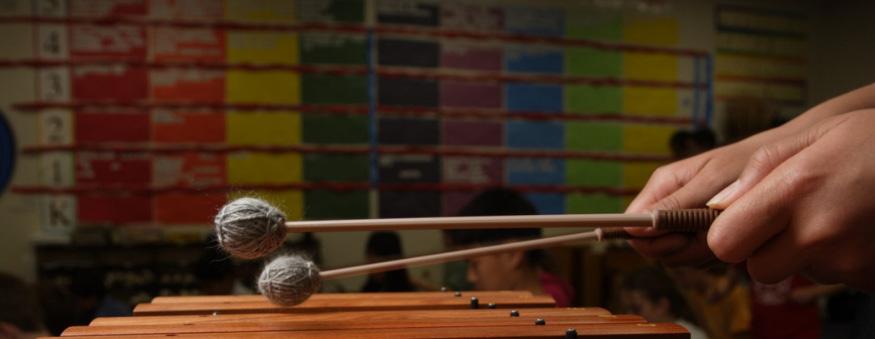

The National Association for Music Education, a voluntary, nonprofit organization representing all phases of music education in schools, colleges, universities, and teacher-education institutions. Active NAfME/AMEA membership is open to all persons engaged in music teaching or other music education work.
Editor & Advertising Manager: Garry Taylor 1600 Manor Dr. NE Cullman, AL 35055 (256) 636-2754 editor@myamea.org



May/June 2024 5
ala breve The Official Publication of the Alabama Music Educators Association May/June 2024 Departments Advertisers 4 AMEA Governing Board Directory 7 AMEA Past Presidents 13 AOA MPA Photos 19 ABA All-State Photos 21 Inaugural Jazz Adjudication Event 22 Lamar Triplett Scholarship Essay, “Legacy” by Hope Jacobs 24 Phi Beta Mu 25 Industry Members 30 Keyboards, Controllers, and Daws, Oh My! by Charles Brooks 32 Recognition of Members Who Donated to AMEA 33 Recognition of Exhibitors Who Donated to AMEA 34 Meet the 2024-2025 AMEA Governing Board 36 Selecting a Saxophone ... by Tracy Heavner 38 General Music Reviews by Jason Jackson 39 The Significance of Borduns by Mason Mays 40 Band Music Reviews by Jeremy Stovall 42 Choral Music Reviews by William Powell 45 Teacher Profile: Chuck Eady 47 Preparing Your Ensemble for a Festival Jazz Collective 50 Schedule of Events 52 AMEA Constitution and Bylaws 7 ���������������������������������� Registar 8 �������������������������������� President 10 Elem/Gen 13 ��������������������������������������AOA 16 �������������������������������������� AVA 18 �������������������������������������� ABA 22 ������������������������������������� HED 24 cNAfME 52 Editor Alabama State University ��������������43 Arts Music Shop ������������Back Cover Blount Awards 9 Gadsden Music Company ������������ 29 Music USA Festivals �����������������������27 Troy University �������������������������������12 UAB ����������������������������������������������������2 UA School of Music �������������������������6 University of Montevallo 53 University of North Alabama �������46 University of South Alabama ������ 35 William Carey University ������������ 41 22 19 13 30 39 45

Pat Stegall
AMEA REGISTRAR
Iam excited that the AMEA board and staff are making plans for the 2025 AMEA Professional Development Conference in Birmingham on January 23-25, 2025. It will be good to be back in Birmingham and I look forward to serving you! The membership deadline is approaching at the end of June, so make sure you renew your membership prior to June

30 so that your membership does not lapse and cause a delay in your conference registration! Make sure to use the link on the AMEA website to join/renew and as soon as the conference registration link becomes available, go ahead, and register for the AMEA 2025 Professional Development Conference! PS
AMEA PRESIDENTS - PAST TO PRESENT
1946 Yale H. Ellis
1948 Walter A. Mason
1950 Vernon Skoog
1952 John J. Hoover
1954 Lamar Triplett
1956 Carleton K. Butler
1958 Mort Glosser
1960 Wilbur Hinton
1962 Lacey Powell, Jr.
1964 G. Truman Welch
1966 Jerry Countryman
1968 Floyd C. McClure
1970 Jerry Bobo
1972 Frances P. Moss
1974 George Hammett
1975 Frances P. Moss
1976 S. J. Allen
1978 W. Frank McArthur
1980 Paul Hall
1982 Lacey Powell, Jr.
1984 Johnny Jacobs
1986 Merilyn Jones
1988 Ronald D. Hooten
1990 Ken Williams
1992 Dianne Johnson
1994 James K. Simpson
1996 Johnnie Vinson
1998 Michael Meeks
2000 John McAphee, Jr.
2002 Tony Pike
2004 Becky Rodgers
2006 John Baker
2008 Pat Stegall
2010 Steve McLendon
2012 Sara Womack
2014 Carl Hancock
2016 Susan Smith
2018 Greg Gumina
2020 David Raney
2022 Rob Lyda
May/June 2024 7

Dr. Rob Lyda AMEA PRESIDENT
In Our End is Our Beginning
Even though we know an ending is coming, we usually aren’t prepared for the ending to appear. The end of a job. The end of a TV show. The end of a career. The end of a school year. A constant in life is that when we start something new, an ending will eventually come. Each new beginning is the start of a journey that leads to an ending.
Endings are interesting. On one hand, endings give us a natural place to reflect and make judgments about the journey we just completed. Many times, endings are a way for people to tout the accomplishments of the journey just completed. Particular endings bring an overwhelming sense of relief because rest is coming. Some endings are a springboard that leads to new adventures.
Endings give us a natural pause for introspection. The value of a journey is often decided at the end. We can decide to dwell on what was or what didn’t happen, or we can celebrate the journey. Sometimes, endings aren’t what you expected or what you wanted. Part of our shared humanity is that we will experience many endings in our lifetime.
I’ve thought quite a bit about endings over the past few weeks. This will be my last President’s column in the Ala Breve. Two years have passed incredibly fast and my term as President of the Alabama Music Educators Association is coming to an end. I will tell you without a doubt,
I am thankful for the journey I have been able to experience serving our Association.
One of my favorite songs is Frank Sinatra’s “That’s Life”. I have vivid memories of listening to the 1966 LP on my grandparents’ record player as a child. If I close my eyes while I listen, I can hear the scratches on the LP and the rotation of the turntable from my youth. There are several different versions of the song by different artists, but for me, it always must be sung by the well-aged and bourbonsoaked voice of Frank Sinatra.
“I’ve been a puppet, a pauper, a pirate, a poet
A pawn and a king I’ve been up and down and over and out
And I know one thing
Each time I find myself layin’ Flat on my face
I just pick myself up and get Back in the race.”
One reason why I love the song “That’s Life” is because of the lyrics above. “I just pick myself up and get back in the race.” Many times over the past few years have we had to shake the dust from our shoes and keep running. COVID, budget cuts, staffing reductions, proration – I’ve seen them all. During each challenge, I’ve seen music educators find a way for music education to continue. We are experts at persevering and performing miracles to ensure children have music in their lives. Things will never be perfect, but we can always be the perfect person to provide music education for our children.
I would like to leave you with a few observations and a bit of advice. Stay vigilant and continue to advocate.
Elected officials are going to continue to pass laws without thinking through the consequences of their actions. Education and in particular, arts education, shouldn’t be a partisan issue. Society will be better if children have access to a comprehensive and wellrounded education that includes music education. We must remain resolute in our demands that our elected officials do what’s right for our children and our state. We must continue to demand children in Alabama have access to music education K-12.
It’s easy to look at Georgia and Florida and see their successes in graduation requirements and diploma seals and be envious. Instead of turning green with envy – advocate and demand the same for our children. Advocacy is a personal responsibility of every one of us. If we want the same success that we see in other states, then we must work for the same successes and demand better for our children. Each of us must work daily to build advocates in our local communities to improve access to music education.
Music education provides a viable career path and builds children’s capacity to be successful in other careers. Americans for the Arts just released the latest “Why Arts Matter” fact sheet for Alabama (https:// www.artsactionfund.org/alabama). According to the latest figures, the Arts and creative sector provides 6.4 billion dollars to Alabama’s economy and accounts for 2.6% of the state’s GDP. Music education can and is a viable pathway to Career and Technical Education. However, we must not allow Career and Technical Education to overtake music education. We must find a harmonious way to exist without one overtaking the other.
8 ala breve
Our profession has stated since the 1960s that secondary music programs only reach 12-20% of secondary students. We must continue to expand music education offerings to attract the other 80% of students in our schools. There are children in our schools who are engaging in music outside of school and would welcome the opportunity to engage in music during the school day. I know how hard you all work and you feel that your plates are overflowing. However, the other 80% want to be involved in music.
What would our schools look like if we offered our traditional bands, orchestras, and choirs, but also offered Modern Band, Music Technology, Guitar, Composition, and other music courses? How many more children would be involved in music education? We are only limited by our own imaginations of what music education could be in Alabama. I would love to see a school where 80% of the secondary students were involved in music education and the state had to pay for additional teaching units for music educators. We must expand our secondary music offerings because some of the children that aren’t involved in our current secondary music offerings will be the decisionmakers of tomorrow.
Our Association needs to speak up for the communities and schools where there isn’t music education. There are places in our state where music programs are limited or non-existent. We must stand in the gap and be the voice for the voiceless. I want every child to have access to music education taught by a certified music educator. The legislature is discussing changing the funding formula for the foundation program in the 2025 legislative session. This could be our opportunity to come together and advocate for the state to fund a music educator in every school.
Take care of each other. Education is hard, but it’s better when you have friends, mentors, and colleagues who check on you. When people ask me why AMEA and NAfME are important - it’s the people and
friendships I have made. I have been blessed throughout my career to have wonderful friends and mentors who have supported me. Many of these relationships exist because of our shared involvement in AMEA. Our early career teachers need the experienced teachers. The experienced teachers need the early career teachers. I encourage you to connect with a music educator in your area every month next year. Have a meal, listen to each other’s ensembles, have a cup of coffee, and make a new friend.
I choose to look at this ending as a springboard to continue the journey. I look forward to finding new ways to serve our Association and music education in Alabama. As I’ve said many times – as long as I have a pulse and breath in my body, I will do everything possible to advocate for music education. Our state and our children need music education in their lives.
I’m excited about the future of our Association. You have selected competent and caring leaders that will propel us to new heights. Congratulations to our newest elected Governing Board members, Dr. Travis Bender – Presidentelect, and Heather Holmes - Recording Secretary! I know you will both do a fabulous job. We are depending on your leadership to drive music education forward.
We have a staff that is dedicated, hardworking, and committed to making our Association the best. Thank you, Rusty, David, Pat, and Garry, for your support of our Association! I couldn’t imagine the past two years without all of
you. Our membership doesn’t fully realize what an asset you are to our Association. Thank you!
Dr. Phil Wilson is going to be a fantastic President and I can’t wait to see what the future holds under his leadership. I know Phil will lead our Association with the same care, grace, intelligence, and warmth that has guided his professional and personal life. I’m thankful that I had the opportunity to serve as President with one of my dearest friends as Presidentelect. Thank you, Phil, for your help and encouragement over the past two years and throughout our careers. I value our friendship more than words can ever describe.
Friends, thank you for your service. Thank you for continuing to show up each day and ensuring children in our state have access to music education. Thank you for selecting me to serve YOU and Alabama’s students. It has been my honor to serve as the President of the Alabama Music Educators Association. I look forward to the journey ahead serving music education in Alabama!

May/June 2024 9

Alicia Luttrell
Elementary/General
Fantastic Elementary Performances!
Greetings to all you elementary music teachers out there! I know all of you are winding down your school year, preparing students for all those year-end performances. If you are like me, it can be exhausting and rewarding at the same time. It does us all good to look back on the year we have had in AMEA as well as look ahead to next year and all the things planned for our AMEA teachers and their students.
After the canceled conference in January, the AMEA executive board was determined to ensure that all student performances were rescheduled. They all worked tirelessly to secure venues and communicate dates and other information with our teachers, students, and parents.
Congratulations to Kitty Stone Singers and director, Cheryl J. Wight, on their outstanding performance in Anniston on February 29. The students were so excited to be able to share the music they had prepared for us at conference in this rescheduled concert. Way to go, Kitty Stone Singers!
 Director
Director
Please consider having your elementary ensemble perform for us at the next AMEA Professional Development Conference in Birmingham at the BJCC. AMEA is now accepting Concert Performance Applications at Concert Performance Application Link, and we need elementary groups to perform. The application deadline is June 1, 2024.
In addition, AMEA is now accepting Session Applications for the 2025 Conference. Please consider applying to present a session Clinic Session Application Link. The application deadline June 1, and accepted clinicians will be notified no later than August 15.
The inaugural performance of our Elementary All-State Choir was held on March 22 in Huntsville. We had 22 teachers and 126 students from 25 schools participate. Greg Gilpin, our guest conductor, led the students all day in rehearsal and in the spectacular
10 ala breve
Kitty Stone Singers, Cheryl J. Wight,


concert that evening. You will definitely want to plan for your students to participate in the next Elementary AllState Choir in 2026 in Birmingham. Your students will learn, grow, and mature as young musicians through this rewarding opportunity.
Now, it is time to look ahead and make sure you are planning for your students to participate in our next Elementary Music Festival scheduled for October 25, 2024, at Metropolitan Church of God in Hoover. The festival is a one-day event designed for students in grades 4-6 that will culminate with a concert open to the public at 6:30 that evening. You do not want to miss the opportunity to have your students work with our outstanding guest clinicians, Dr. Erika Knapp and Dr. Morgan Luttig.

Dr. Erika Knapp

Dr. Morgan Luttig
I hope you all have had a productive school year, and I sincerely wish you a restful summer. Be sure to keep your AMEA membership current so your students can benefit from all these wonderful AMEA opportunities. Also, be sure to follow AMEA Elementary on Facebook for the latest updates and reminders. Your Elementary board members and district chairs look forward to seeing you next year.
Elementary executive board
• President – Alicia Luttrell
• President-Elect – Jason Jackson
• Treasurer – Devin Lacey
• Secretary – Melissa Galanopoulos
• Past-President – Sarah McLendon
• Festival Director—Taylor Knuppel
District Chairs
• District 1: Lea Hoppe & Viktoria Truesdail
• District 2: Karen Morgan & Jamie Howell
• District 3: Trudye Confessore & Kris Lindley
• District 4: Laura Clevenger & Kaitlyn Melton
• District 5: Katie Boyd
• District 6: Christy Clark
• District 7: Regina Williams
• District 8: Andrea Marsh
May/June 2024 11
The Elementary All-State Choir, Greg Gilpin, Guest Conductor


Joseph Lee Alabama Orchestra Association
Members of the Alabama Music Educators Association,
The Alabama Orchestra Association’s Orchestra Music Performance Assessment (OMPA) 2024 was held on Friday, April 5, 2024. It was a full day highlighting the accomplishments and development of orchestras and string ensembles from across Alabama, and the day was an enormous success. Our stage judges were Dr. Christina Volz Stomackin (University of North Alabama), Dr. Annalisa Chang (Clayton State University), and Mr. David Metrio (Gwinnett County Public Schools), and our sightreading judge was Dr. Christopher David Thiem Lawhorne (University of Alabama). Participating ensembles included:
Thompson High School Philharmonic (Alabaster)
Jordan Ford, conductor
Thompson Middle School Orchestra (Alabaster)
Jordan Ford, conductor
Emma Sansom Strings (Gadsden)
Emma Dilley, conductor
Ramsay High School String Orchestra (Birmingham)
Rachel Christmas, conductor
Carver Elementary and Arts Magnet Strings (Birmingham)
Tabitha Holder, conductor
G.W. Carver High School Orchestra (Birmingham)
Catherine Cochran, conductor


Academy for Academics and Arts M.S. Sapphire Strings (Huntsville) Mary Peck, conductor
Gadsden Middle School String Orchestra (Gadsden)
Rachel Sherrod, conductor
Gadsden City Titan Orchestra (Gadsden)
Keith LaBenne, conductor
Graceful Glissandos (Birmingham)
Layla Humphries, director

I am grateful to the administration, faculty, and staff at Thompson High School for donating the use of their gorgeous Performing Arts Center.
Thank you to Dr. Wayne Vickers (Superintendent), Michael Lee (Principal), Jordan Ford (Orchestra Director), Graham Bennett (Band Director), Corey Hyman (Band Director), and Michael Giddens (Technical Director).
In February, at the All-State Orchestra Festival in Tuscaloosa, the membership of AOA elected officers that will serve a two-year term, beginning June 1, 2024. They are:
May/June 2024 13
GADSDEN MIDDLE SCHOOL ORCHESTRA IN SIGHTREADING
GRACEFUL GLISSANDOS IN WARM UP
President: Jordan Kirchner Ford is a native of Knoxville, TN. She attended Samford University where she received her Bachelor of Music Education. She taught general music and strings for 4 years in Birmingham City Schools before becoming the Orchestra Director at Alabaster City Schools in the Fall of 2021. Jordan currently teaches the orchestra classes at Thompson Intermediate, Middle, and High Schools. She is also the youth orchestra manager for the Alabama Symphony Orchestra. Jordan went on to receive her Masters in Special Education with a concentration in Early Childhood Special Education in the spring of 2022. Jordan has been playing the violin since she was four years old and has actively played in amateur and professional orchestras ever since. She lives in Chelsea, AL, with her music teacher husband, 4 year old, and two fluffy, white dogs.
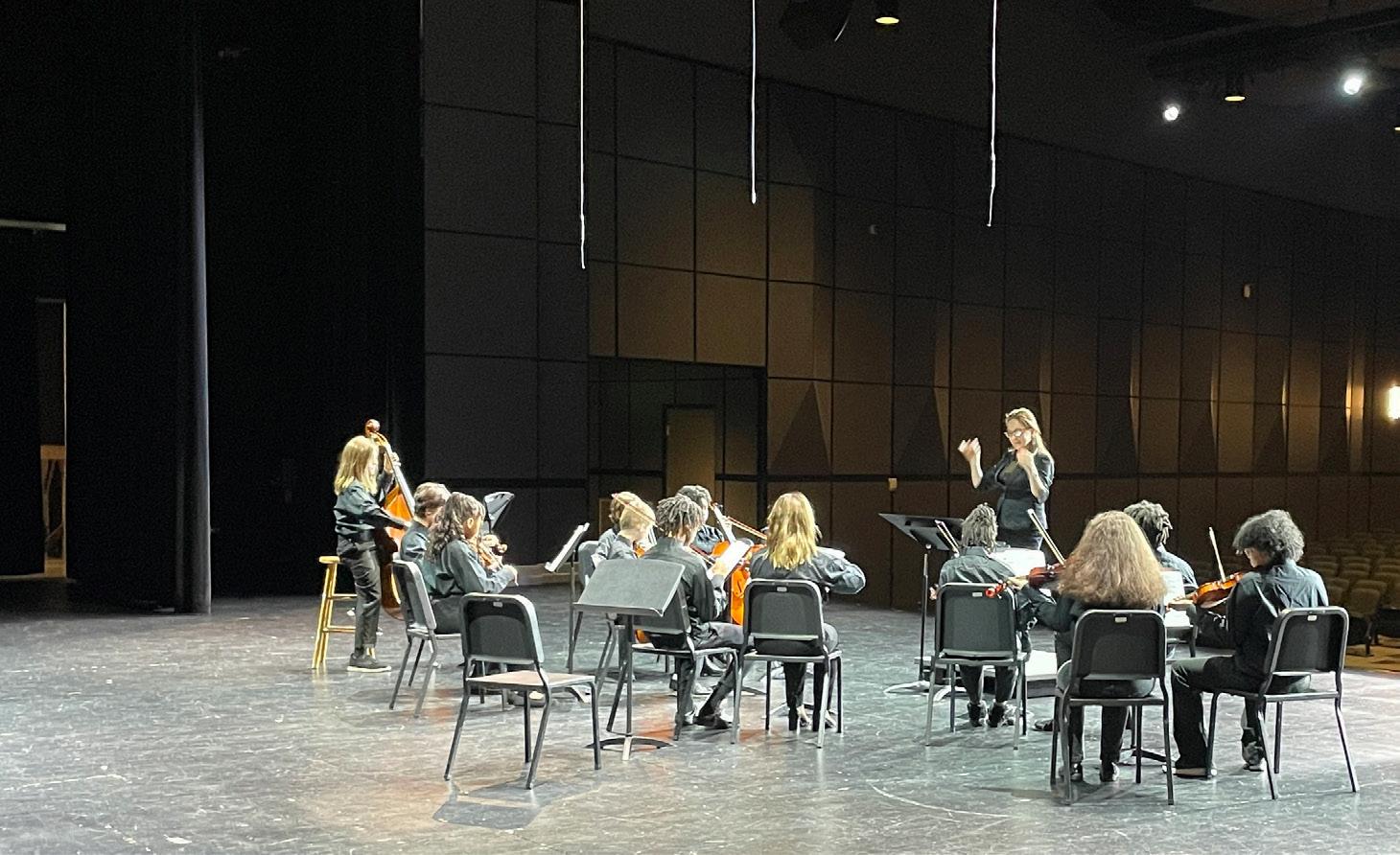
Past President: Joseph Lee is the Resident Conductor of the Huntsville Symphony Orchestra, Music Director of the Huntsville Youth Orchestra, Music Director of the Tennessee Valley Music Festival, Music Director of the Festival Internacional de Música Cóbano (Costa Rica), the Director of Music Ministries at East End United Methodist Church in Nashville, the Principal Conductor of Nashville’s professional modern music ensemble, “chatterbird,” and
the Artistic Director of Nashville in Harmony’s youth chorus, Major Minors. Joseph has served on the faculties of Vanderbilt University, Sewanee: The University of the South, University of Alabama Huntsville, and recently served a one-year appointment as the Interim Director of Orchestral Studies at the University of Alabama. A bassoonist and cellist, he has developed a passion for Eastern music and studies the Japanese shakuhachi and the Armenian duduk. Joseph will finish his Master of Divinity at Claremont School of Theology in December of 2024 and will be commissioned as a Deacon in the United Methodist Church this June.
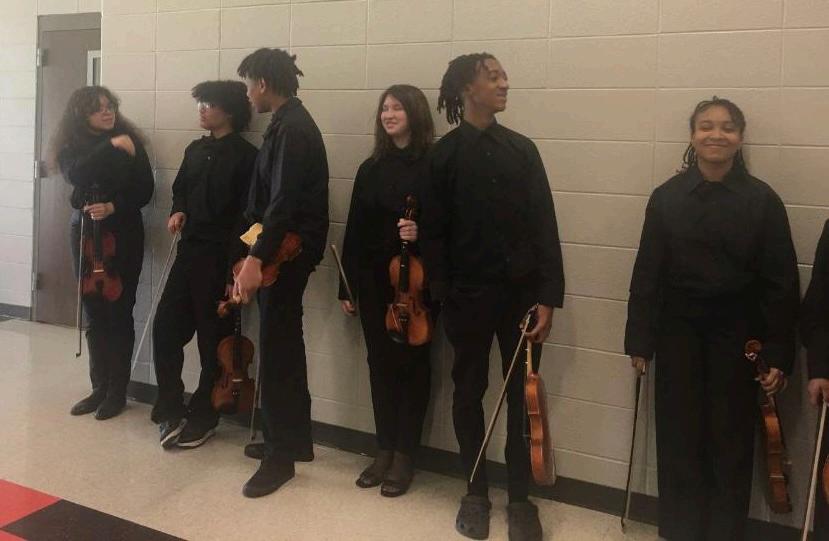
Vice President/President-Elect:
Keith LaBenne is the Orchestra Director at Gadsden High School and received his Bachelor of Music Education from Jacksonville State University. His own journey playing string instruments began in a school orchestra class when he was in the 6th Grade. He chose to be a part of both the orchestra and the band programs. At JSU he was a member of the Marching Southerners and the JSU Community/University Orchestra founded by Dr. Victor Vallo. Keith was a founding member of this orchestra and continues to play in it today. Over the years, he has played in numerous string quartets, musical/pit and church orchestras, the Gadsden Symphony Orchestra, and the Red Mountain Chamber Orchestra. He also plays bass in bluegrass bands, including the
14 ala breve
HUNTSVILLE STUDENTS ANXIOUSLY AWAITING SIGHTREADING
AAA ORCHESTRA WITH MARY PECK ON STAGE
Distant Cousins and Kelli Johnson and Chimney Peak. Keith enjoys spending time with his family and taking care of his chickens.
Treasurer: Tricia Marotz teaches violin, viola, cello, guitar, and bass, and has owned TM Music Studio since 1997. She is a member of Staccatti, a string quartet, and serves as the Concertmaster and President of the Board for the Tri-State Community Orchestra in Dothan. She received her Bachelor of Fine Arts at Utah State University. Tricia’s favorite style of music is classical, but she is eclectic, enjoying performers like Lindsey Sterling, the Piano Guys, and Pentatonix.
Secretary: Rachel Christmas is a Detroit native and began playing violin at the age of six. She pursued her passion for music through private lessons, concerto competitions, youth orchestra ensembles, including the Metropolitan Youth Symphony Orchestra and the Huntsville Youth Orchestra. Rachel pursued her undergraduate studies at Birmingham-Southern College and received her Masters in Music Education from the University of Michigan in Ann Arbor. During her time as a student, she performed with the Alabama Youth Symphony Orchestra, the Red Mountain Chamber Orchestra, the Samford University Orchestra, the Concert Choir, as well as the Marching and Symphonic Bands. Rachel has taught in Gadsden and Birmingham, and currently serves as the Orchestra Director at Ramsay High School. She enjoys traveling, cooking, and spending time with her family.

Members of the AOA and beyond, thank you for all that you do to ensure that orchestral music education thrives in the State of Alabama. May we continue to build musical communities where our students find safe spaces to express themselves, their experiences, their hopes, and their dreams for a kinder world where all are loved, nurtured, and supported. May this be our mission and may music be our vehicle.
Musically yours,
Joseph Lee, President
It has been an honor to serve as the President of the Alabama Orchestra Association for the past two years. I am proud to tell you that orchestral music education is vibrant and so alive in many areas of Alabama, but we have much work to do. I must remind you that approximately one-third of Alabama schools do not have a music teacher. It is the sincere hope of the Alabama Orchestra Association and Alabama Music Educators Association that, someday, every public-school student in Alabama will have access to this art form if they desire to participate. Help spread the word about the work we are doing to your community, colleagues, friends, family, local media outlets, and government officials. Let your legislators know that you, too, dream of a day where all Alabama children will have the opportunity to have their lives enriched through the arts.
Important Dates for AOA 2024-2025 Academic Year
• String Scales/Etudes/Excerpts posted to website: July 1, 2024
• Woodwind/Brass/Percussion Scales/Etudes posted to website: August 8, 2024
• Strings/Harp/Piano audition videos due: October 18, 2024
• Woodwind/Brass/Percussion audition videos Due: November 15, 2024
• 2025 All-Region Orchestra Festivals: January 11-12, 2025
• North Region: Huntsville | South Region: Greenville
• 2025 AMEA Conference: January 23-25, 2025 | Birmingham
• 2025 All-State Orchestra Festival: February 13-16, 2025 | Tuscaloosa
• Orchestra Music Performance Assessment: April 2025 (TBA) Thompson High School | Alabaster, Alabama
May/June 2024 15
THOMPSON MIDDLE SCHOOL ORCHESTRA IN WARM UP

All-State
Hilen Wilson Alabama Vocal Association
Thank you again to everyone who contributed to making this year’s AllState Choral Festival a success. This event would not be possible without so many of you being willing to serve as choir coordinators, transportation coordinators, rehearsal monitors, concert coordinators, and so many other jobs. It takes all of our wonderful directors to put on such a successful event. I hope the festival was a wonderful experience for your students and that they brought their enthusiasm back to your choir rooms.
At our general membership meeting, we finalized our teacher panel to evaluate our All-State audition process. They will be meeting and creating a report to present to the board. If you are interested in being on this committee, please let us know.
We will be returning to the BJCC for All-State Choral Festival on April 3-5, 2025. I look forward to seeing you all there.
Fall Workshop
We had a wonderful time this past
year at the University of Montevallo. For this year’s Fall Workshop, we will return to Huntingdon College in Montgomery on Friday, September 6.
If you have anything you would like to present at Fall Workshop or any sessions you would like to see presented, please let me know.
AMEA
We will be returning to Birmingham for the 2025 AMEA Professional Development Conference on January 23-25, 2025.
 AVA GOSPEL CHOIR
AVA GOSPEL CHOIR

Please consider submitting to present a session or to have your choir perform at the conference. The deadline to apply is June 1 and the application may be found on the AMEA website under the “Conference” tab under “Apply to Perform or Present.” There were so many great performances and sessions

at the conference this year, so please submit so we can continue highlighting the excellent choral music from across our state.
Honor Choir
We are so grateful that we were able to have our rescheduled Honor Choir in Huntsville in March. Our students enjoyed our clinician, Dr. Valerie Harris, and they presented an amazing concert in conjunction with the Elementary All-State Choir. We are thankful to Huntsville First Baptist Church and to the elementary division for collaborating for this performance.
ASSC
Thank you so much to everyone who participated in our All-State Show Choir Festival. Thank you again to Cameron Johnson for running such a successful event as Show Choir Coordinator and to Kate Dupuis at Hartselle High School for hosting.
Summer Board
This year’s Summer Board meeting will be held on June 2-5. If you have feedback or any items you would like me to add to our agenda for discussion and review during our meeting, please provide that to me through written feedback prior to June 1. You may do
that by emailing me at hilen.wilson. ava@gmail.com or by completing the membership survey that was sent to your email at the beginning of May.
I would like to take this time to say a huge thank you to the board for their constant support and help throughout the past two years. I truly could not have managed without them. It has been a true honor serving as your president for the last two years. The Alabama Vocal Association has given me and my students so much and I am grateful that I had the opportunity to give something back.
I hope you all have a wonderful summer and are able to find some time to reflect on this school year and to rest and refocus for this coming fall. If I can be of help to you in any way, please let me know.
I look forward to seeing you all at Fall Workshop!
Hilen
17
DISTRICT OUTSTANDING CHORAL STUDENTS AND MUSIC EDUCATION WINNERS

Lori Hart Alabama Bandmasters Association
Reflecting on the 2024
All State Band Festival
For many, band is more than just a musical pursuit; it’s a transformative journey filled with camaraderie, discipline, and personal growth. As I sit here, the day after our 2024 All State Band Festival, I’m reminded of the numerous individuals whose lives have been enriched by their participation in band. From large metro areas to quaint rural communities, the spirit of music resonates deeply, weaving its melody into the very fabric of our society.
The countless hours spent by so many individuals helped to assure this year’s All State Festival was a success. We kicked off the festival with our President Elect, Keith Anderson doing a fantastic job with our Solo Festival. I commend the eighty two participants in the prelims, who poured their hearts and souls into their performances. Congratulations to Thomas Washer for his first place finish along with our other finalists: Benjamin Bailey, Noah Bender, Madeline Cagle, Kenimer Lewis, Riley Morris, Gloria Phillips, Landon Roberts, Rachel Strong, and Elijah Winslet. To celebrate 25 years of this event, beginning in 2025, the Solo Festival winner will be awarded the Glenn Spiller Solo Festival
Solofest Winners
Scholarship. Thank you Glenn for the vision you had for this festival!
Our All State Band conductors were absolutely incredible and gave so much of themselves to our students. I am so appreciative of our hosts and percussion techs; Red Band conductor Mr. Richard Floyd was hosted by Jon Bubbett and Rebekah Hammock, White Band conductor Dr. Sue Samuels was hosted by Heather Henson and Doug Teuscher, Blue Band conductor Mrs. Carol Brittin Chambers was hosted by Damon McAllister and Alex White, Red Band MS conductor Mrs. Cheryl Floyd was hosted by Tim and Connie

18 ala breve
1-Thomas Washer, Alto Saxophone, Helena High School
2-Madeline Cagle, French Horn, Spain Park High School
3-Kenimer Lewis, Flute, Grissom High School
4-Gloria Phillips, Clarinet, Pelham High School
5-Landon Roberts, Oboe, Baldwin County High School
6-Noah Bender, Trumpet, Hewitt-Trussville High School
7-Elijah Winslett, Trumpet, Buckhorn High School
8-Riley Morris, Alto Saxophone, Hewitt-Trussville High School
9-Rachel Strong, Flute, Rocket City Band Collective
10-Benjamin Bailey,Euphonium, Hewitt-Trussville High School ABA
Hammond and Josh Lynch, and White Band MS conductor Mr. Mickey Smith Jr. was hosted by David Caddell and Courtney Langford. The Percussion equipment was organized and provided for all of our bands by Red Band Keith Anderson of James Clemens HS; White Band Jack Albert of Sparkman HS; Blue Band Kevin Smart of Bob Jones HS; MS Red Band Andrew Kirk of Huntsville HS; and MS White Band Clay Sloan of Austin HS.
Thank you to our clinicians, Dr. Demetrius Scott, Dr. Ed Nichols, Greg Faulkner, Chris Pennington, Matt Weaver, Nick Staff, Jared Holland, and Jonathon Steinman. They brought some wonderful ideas to the discussion! I also need to thank the awesome exhibitors that we had! The venue was always busy and it is exciting to see new products and concepts being brought into our band world!
“To everything, there is a season and a time for every purpose under heaven.” Thank you to the members of the Rho Chapter of Phi Beta Mu for their commissioned composition “There Is a Season” by Dr. Larry Blocher, in honor and remembrance of our friend and colleague, Robert W. Smith. The premier performance by the Red Band was a fitting tribute to Robert’s history, whereas as a high school trumpet player, he performed in the Alabama All-State Red Band. In 2015, Robert returned to the All-State Festival as the conductor of the Red Band. Please continue to keep Robert’s family and friends in your thoughts and prayers.
As I reflect on the All State Band Festival and the broader impact of band programs in Alabama, I’m filled with a profound sense of gratitude. Gratitude for the dedicated members of the entire ABA Board, who tirelessly work behind the scenes to assure our students have
opportunities to grow and experience musical moments that they will cherish for a lifetime. I am grateful to have served on the ABA Board with our outgoing District Chairmen Nathan Haskew D2, Dr. Travis Bender D4, Deanna Marshall D6 and Adam Brumberg D8. They have given of their time, energy and leadership selflessly, and it is appreciated by all of us.
In the end, band is not merely an extracurricular activity; it’s a way of life—a testament to the power of music to uplift, inspire, and unite us all. As we look to the future, let us continue to cherish and celebrate the transformative magic of all things band in Alabama and beyond. May you all have a peaceful ending to the school year, filled with gratitude for all that we have accomplished.
ABA All-State 1st Chair Players
HS Red Band

Clarinet-Kathryn Baker, Hoover HS; Bass Clarinet-Katt Terry, American Christian Academy; Contra Bass Clarinet-Zao Nelems, Oak Mountain HS; Alto SaxophoneAnthony Green, Sparkman HS; Tenor Saxophone-Thomas Washer, Helena HS; Baritone Saxophone-Elijah Boyd, Hoover HS; Trumpet-Noah Bender, Hewitt Trussville HS; French Horn-Christian Pate, Straughn HS; Trombone-Davis Brewster, Grissom HS; Baritone-Matthew Eldridge, Alma Bryant HS; Tuba-Gannon McNees, Grissom HS; String Bass-Noah Sugg, Fairhope HS; Percussion-Mary Mollie Lewis, Auburn HS
May/June 2024 19
Piccolo-Rachel Strong, Rocket City Band Collective; Flute-Hope Jacobs, Meek HS; Oboe-Landon Roberts, Baldwin County HS; Bassoon-Lujue'la McEntyre, ASFA;
ABA All-State 1st Chair Players
HS White Band
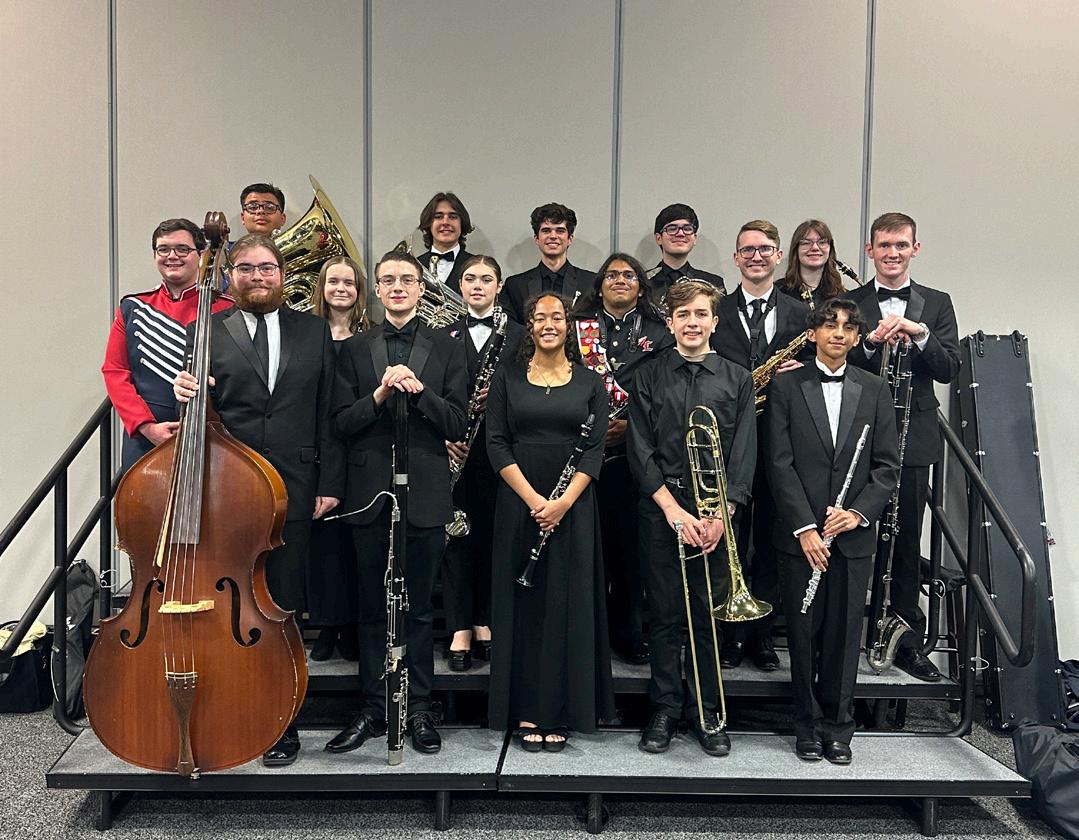
Piccolo-Josie Rhone,Hartselle HS; Flute-Miguel Rodriguez, Prattville HS; Oboe-Sofia Cagle, Spain Park HS; Bassoon-Cason Pierce, St. Clair County HS; Clarinet-Misha Temesgen, Auburn HS; Bass Clarinet-Meredith Bates, Fairhope HS; Contra Bass Clarinet-Matthew Cornelius, Trinity Christian School; Alto Saxophone-Paul Dungan, Fultondale HS; Tenor Saxophone-Jesse Ramos,East Limestone HS; Baritone Saxophone-Sydney Smith, Enterprise HS; Baritone Saxophone-Chip Odom, Trinity Christian School; Trumpet-Parker Smith, Hewitt Trussville HS; French Horn-Carson Phillips, Hewitt Trussville HS; Trombone-Nathaniel Wright, Florence HS; Baritone-Ephraim Nunnally, Mortimer Jordan HS;Tuba-Michael Madera, Rehobeth HS; String Bass-Abram Griffith, Scrollworks Music School; Percussion-Matthew Diffey, Oak Mountain HS
Band

Piccolo-Erin Bruce, Monrovia Middle; Flute Bailey- Cunningham, Auburn JH; Oboe-Ben Brown, Mountain Brook JH; Bassoon-Daniel Su, Pizitz MS; ClarinetRiley Lyndon, Pizitz MS; Bass Clarinet-Locky Courson, Central Baldwin MS; Contra Bass Clarinet-Caedmon Dark, Simmons MS;Alto Saxophone-Samantha Li, Phillips Prep; Tenor Saxophone-Gentry Bilyeu, Shoals Christian; Baritone Saxophone-Allie Owens, Montgomery Catholic Prep; Trumpet-Liam Skala, Montgomery Catholic Prep; French Horn-Savannah Haley, Leeds MS; Trombone-Lawson Ledbetter, Monrovia MS; Baritone-Noah Renfroe, Pleasant Valley HS; Tuba-Preston Samuels, John Herbert Phillips Academy; String Bass-Avie Thompson, Pizitz MS; Percussion-Hudson Rogers, Hewitt Trussville MS
HS Blue Band

Piccolo-Bosco Ni, Mobile Christian School; Flute-Sarah Kate Smith, Hewitt Trussville HS; Oboe-Brayden Flowers,Northridge HS; Bassoon-Dash Dixon,Austin HS; Clarinet-Isaac Heinze, Cullman HS; Bass Clarinet-Francisco Valera-Flores, Rehobeth HS; Contra Bass Clarinet-Phillip Olk, Enterprise HS; Alto Saxophone-Shane Tucker, Hayden HS; Tenor Saxophone-Casie Tidwell, Winfield City HS; Baritone Saxophone-Tyree Davis, Sparkman HS; Trumpet-Austin Kintz-Roberts, Auburn HS; French Horn-Ava Larkin, Marbury HS; Trombone-Anthony Hathcock, Thompson HS; Baritone-Rosie Patterson, Grissom HS; Tuba-Chase Ellington, T. R. Miller HS; String Bass-Robert Stefurak, W.P. Davidson HS; Percussion-Sophie Hodges, Florence HS

Flute-Seyeon Lee, Auburn JH; Oboe-Molly Wilson, Berry MS; Bassoon-Noah Mendenhall, Trinity Christian School; Clarinet-Aidan Cui, Oak Mountain MS; Bass Clarinet-Sean Zink, Monrovia MS; Contra Bass Clarinet-Kahlan Jolley, Liberty MS; Alto Saxophone-David Lee, Auburn JH; Tenor Saxophone-Chloe McMillan, Da Smith MS;Baritone Saxophone-Elijah Petit, Bumpus MS; TrumpetLucas Harrington, Oak Mountain MS; French Horn-Izek Phelps, Alabama Christian Academy; Trombone- Foster Thornton, Central (Florence); BaritoneAubrey Snow Bumpus MS; Tuba -Kayden Rodriguez, Geneva County HS; String Bass-Angela Rastrero Martin, Auburn JH; Percussion-Charles Zalamea, Liberty MS
20 ala breve
MS Red
MS White Band
Alabama’s Inaugural Jazz Adjudication Event: A Resounding Success
Nick McDonald, Jazz Education Chair

On April 18, 2024, the heart of jazz echoed through the halls of Thompson High School and Hillcrest High School as Alabama proudly hosted its inaugural jazz adjudication event. Thirty bands from across the state took center stage, showcasing their talent and passion for jazz.
The event not only provided a platform for these bands to perform but also offered invaluable feedback from a panel of esteemed judges. This constructive
criticism serves as a guiding light for the musicians, helping them refine their craft and elevate their performances to new heights.
Behind the scenes, there were countless individuals whose dedication and hard work made this event possible. We extend our sincerest gratitude to Graham Bennett, Corey Hyman, Meghan Miller, and Chase Moore for graciously hosting the event at Thompson and Hillcrest High Schools. Their hospitality created

a warm and welcoming environment for all participants.
The adjudication panel, comprised of Joe Smith, Jose Carr, Dr. Steve Roberts, Dr. Dave Camwell, Kim Bain, Tom Wolfe, Dr. Matt Leder, and Dr. Mark Foster, brought a wealth of expertise and insight to the table. Their thoughtful assessments and encouragement inspired the musicians to continue pursuing their passion for jazz.
None of this would have been possible without the visionary leadership of Dr. Ben Posey, who tirelessly championed the legislation for this event. His unwavering commitment to promoting jazz education has laid the foundation for future generations of musicians to thrive. We also extend our gratitude to Kelvin Benion, the jazz chair-elect, for his invaluable support throughout this process.
As the curtains close on Alabama’s inaugural jazz adjudication event, we reflect on the celebration of music and camaraderie that filled the air. This event marks a significant milestone for our state’s jazz community, and we eagerly anticipate its growth and evolution in the years to come. Here’s to the enduring legacy of jazz and the boundless possibilities that lie ahead.
May/June 2024 21
Legacy
by Hope Jacobs
Legacy is a term that describes what a person leaves behind. Legacy refers to one’s memories and long-term influence on another person. When considering the legacy educators might leave behind, a quote that stands out to me from William Arthur Ward states: “Teaching is more than imparting knowledge; it is inspiring change. Learning is more than absorbing facts; it is acquiring understanding.” The lineage of music educators I have been exposed to, how music has impacted me personally, and how I have been able to touch others through music are all compelling factors as to why I want to be a band director.
There is lineage within legacy. The people who inspire were once inspired. I am very grateful to have grown up in a musical family. My mother and father were ministers of music my whole life. My mother and band director are two direct influences who have led me down a path of music education. My mother was fortunate enough to be educated by a Troy State graduate, Pamela Goad, her high school band director, who had musical ties to Truman Welch. Dr. Simpson, her professor, was another huge influence in her life as well as her flute teacher Gloria Simpson, and Dr. Edd Jones, her college director. She graduated from the University of North Alabama with a music education degree and also served as drum major for the Pride of Dixie Marching Band from 1985-1987. Dr. Edd Jones, her college

band director, was influenced by Col. Butler and Truman Welch, who have significant legacies of their own. My band director, Zach Cleghorn, was directed by Nancy Frith in high school and Dr. Lloyd Jones in college. Nancy Frith, a music educator, and UNA alumnus, carried on the Meek High School “Band of Champions” traditions from Ken Williams, a University of North Alabama graduate and former Phi Beta Mu president. Dr. Llyod Jones continues his father’s legacy, Dr. Edd Jones, and was the director for my three older sisters, all UNA grads who marched in the Marching Pride. One of them was my sister Hannah Jacobs, who also served as drum major. Behind every excellent band director is a music educator who instills a passion for music in their students. Ken Williams’ effects on my high school band when he was the band director have been longlasting, and I have been able to benefit from Nancy Frith who continued on the legacy he left behind, as well as building her own. Her own student, my band director Zach Cleghorn, returned after graduation to teach at the school where he developed his passion for music. The world of music education is a circle that begins with one person and then eventually circles back. When I think about all the ways these people were connected it is much like the circle of fifths; as music is just notes on a page, the circle of fifths represents how those notes are connected. Perhaps the circle of all these relationships centered around music holds even more value
in life. Every beneficial impact of an educator encourages future educators; the legacy never dies.
Music and the experiences I have had through my high school band program have had a significant impact on me. I have been in band since fifth grade, where I began playing the flute and then the piccolo. My mother and older sisters instilled in me a love for the flute; I grew up hearing them play. I started marching band in seventh grade. I was an ambitious rookie who only wanted to impress my section leader and band director. I later became the section leader, where I gained the knowledge to instill eagerness in my section and other rookies, and the significance of it. I earned the position of drum major during my junior year. The opportunity and responsibility of being the leader, with all of its challenges and learning experiences, shaped me into the person I am today. I was the drum major for both my junior and senior years, and it taught me the value of selfless and courageous leadership. The right decision is not always popular, but in the end, you will be respected for doing the right thing. A leader stands out from the crowd because they do tasks that no one else wants to do. It is not a position for one to be acknowledged; rather, it is awarded
22 ala breve
Phi Beta Mu Lamar Triplett Scholarship Hope Jacobs, Meek High School
Phi Beta Mu Lamar Triplett Scholarship Essay
to someone responsible enough to hold others accountable and strong enough to bear the consequences of their own and others’ mistakes. Learning these useful lessons is essential for the job of a band director. A band director is ultimately accountable for all of the band students and the program. They have to make tough decisions and work long hours. However, the benefits of developing a program that produces great and capable musicians and leaders are worthwhile in the long run, and this is what I intend to achieve when I become a band director.
The ability to make an impact on others is a key motivator for me to pursue a career as a band director. I have been able to educate young beginning band students and encourage them to pursue music. I recall what band was for me as a beginner. It was a “home”, and it offered me a family separate from my own. It was a location where I could fit in at school with like-minded students. It’s a great feeling to be able to share that experience with others and watch them thrive. Music allows me to express my creativity and passion while also providing me with fulfillment and purpose. I never want to live a life without music in it. When I helped teach beginner flute students, I quickly realized how much I appreciated sharing my creative space with others. All the beginners required was encouragement. When I was a beginner, being encouraged even when I felt I was not good enough motivated me to keep going. That is the main job of a band director. To provide kids with the tools and resources they need to flourish, and be there to guide them through it fostering a legacy and pride for what music is and what it provides to the world. That is a huge aspect of music education and a part that is very important to me. I taught lessons to a young girl during my sophomore year. She was really shy and reserved. When she played the flute, she was too insecure in her own talent and avoided playing in front of others. One day, before the other flute beginners arrived, I sat down with her and told her that I saw unbelievable potential in her and that she should let her abilities shine. I mentioned how I was once in the same situation as her, but I quickly found that band is a place where those anxieties can evaporate and you can blend into a group
of students just like you who are facing the same fears, and share the music that calms those thoughts. Following that, I observed her come out of her shell and embrace the musical environment she was in. I will never forget how it felt to see someone gain confidence and witness them develop into the talent they possessed all along. That encounter helped me understand that education was the right path for me.
The reasons I want to be a band director stem directly from the lineage of band directors who have inspired me through the legacies they have left behind, as well as how music has personally influenced me and allowed me to influence others. I have learned that the monetary compensation for one’s time is minimalistic compared to the legacies you leave in others. I want to be remembered as someone who shared her love and passion for music and helped people grow as individuals, even in the smallest impressions. Educators can lose sight of what education encompasses and how vital their involvement is in igniting or destroying someone else’s passion. Music will never cease; it is boundless, as long as we continue to nurture it. As William James famously stated, “The greatest purpose of life is to live it for something that will last longer than you.” My legacy is only beginning, but I am confident that through music, I can make a difference in other people’s lives.
Works Cited
“William Arthur Ward Quotes” FinestQuotes. com, https://www.finestquotes.com/author_ quotes-author-William%20Arthur%20Wardpage-0.htm. Accessed 1 Mar. 2024.
“65 Quotes About Leaving A Legacy” Externa, 20 Dec. 2022, https://www.eterneva. com/resources/65-quotes-about-leavinga-legacy#:~:text=A%20life%20sto ry%20 longest%2Dlasting,will%20last%20nger%20 than%20you.%E2%80%9D. Accessed 1 Mar. 2024.
The reasons I want to be a band director stem directly from the lineage of band directors who have inspired me through the legacies they have left behind, as well as how music has personally influenced me and allowed me to influence others.
May/June 2024 23


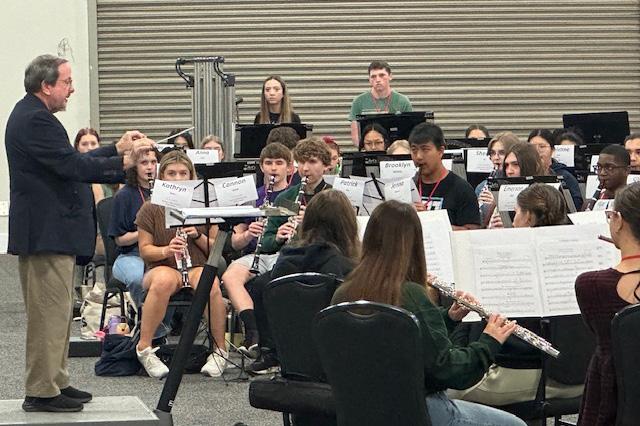
Dr. Larry Blocher conducting the All-State Red Band on his composition, There is a Season, commissioned by the Rho Chapter of Phi Beta Mu









24 ala breve
John Cooper presents the Outstanding Young Bandmaster Award to Jessica Hood
Jon Bubbett presents the Outstanding Bandmaster Award to Lori Hart
Josh Lynch sponsored by Harry McAfee
Will Petersen sponsored by Lori Hart
Jamar Dumas sponsored by Steve McLendon
Pinning New Members
Jeremy Stovall sponsored by Chris Lindley
Brandon Peters sponsored by Mark Foster
Stuart Tankesley sponsored by Jerry Potter
Daniel Seay sponsored by Terry Ownby
Travis Bender sponsored by Joe Terry
AMEA Industry/Institutional Membership 2023-2024
AMEA would like to express appreciation to the following partners who have joined AMEA in our efforts to promote music education in Alabama. Please support these industry/institutional members who support you as music educators!
Alabama Symphony Orchestra
3621 Sixth Avenue South, Birmingham, AL 35222 https://www.alabamasymphony.org/
Auburn University Department of Music
132 Goodwin Music Building, Auburn, AL 36849https://cla.auburn.edu/music/
American Travel Consulting
P.O. Box 750, Albertville, AL 35950 https://www.americantravelconsulting.com/
Collins Hornworks
5256 Willow Way, Birmingham, AL 35242 https://collinshornworks.com/
Fink’s
Music
1604 Mockingbird Ct. Unit #A, Florence, AL 35630 https://finksmusicschool.com/
Gadsden Music Company
607 Broad St., PO Box 132, Gadsden, AL 35901 https://gadsdenmusic.com/
Jay and Susie Gogue Performing Arts Center
910 South College Street, Auburn, AL 36849 https://goguecenter.auburn.edu/
Group Travel Network
5401 S. Kirkman Rd. Suite 530, Orlando, FL 32819 https://grouptravelnetwork.com/
J.W. Pepper of Atlanta
9053 Riverside Parkway, Lithia Springs, GA 30122 https://www.jwpepper.com/
Marchmaster
14 Lake Point Drive, Dahlonega, GA 30533 https://marchmaster.com/
Sight Reading Factory
1321 Upland Drive, Suite 12621, Houston, TX 77043 https://www.sightreadingfactory.com/
Southern Performances
427 Appollo Avenue, Gulf Shores, AL 36542 https://southernperformances.com/
Super Holiday Tours
116 Gatlin Avenue, Orlando, FL 32806 https://superholiday.com/
The University of Alabama School of Music
810 2nd Avenue, Tuscaloosa, AL 35487 https://music.ua.edu/
The University of North Alabama
UNA Box 5040, Florence, AL 35632 https://www.una.edu/schoolofthearts
The University of South Alabama Department of Music
5751 USA Drive South, Mobile, AL 36688 https://www.southalabama.edu/colleges/music/
Troy University John M. Long School of Music
112 Long Hall, Troy, AL 36082 https://www.troy.edu
May/June 2024 25

Passing the Baton
Dr. Carly Johnson Higher Education
children to explore by way of handson learning.
Moving toward the close of another school year is always a good time to reflect on the past twelve months. In doing so, I always think back to those special teachers, colleagues, and experiences that have helped shape my career along the way and that continue to fuel my passion for teaching. I’m a graduate of the Dana School of Music, located in northeast Ohio, right between two major cities, Cleveland and Pittsburgh, and like many regional institutions with nearby access to larger metropolitan areas, the Dana School of Music has produced many outstanding graduates in the field of music over the years that have helped shape the local music scene in northeast Ohio.
I realize now how fortunate that I was to grow up in a small town where the local school district had an amazing elementary school music teacher. Those early experiences of using rhythm sticks to learn how to count beats, using Orff instruments to learn to differentiate between pitch while learning the names of line and space notes, and using recorders to transition into a beginning band class were invaluable to my and other students’ development. I attribute a good deal of our district’s success at the secondary level directly to those early experiences and weekly visits to the music room, which for me and many other children, was a magical space. My heart sinks every time that I go into a K-5 school now and do not see a music specialist available to meet weekly with students, or when I walk into a music room that has no classroom instruments for young
I, like many others in our field, am incredibly concerned about the future of Arts education in Alabama and in our country. From music being eliminated entirely in schools, to schools not being able to find any certified, trained teachers to fill vacated positions. I often hear idealistic phrases such as “music is for everyone,” but the actions of local and state school boards often do not mirror this sentiment. Music and the Arts are often still relegated as an afterthought and are often not recognized or considered an essential part of the curriculum, like our STEM counterparts. For anyone concerned about Arts education in America, Malcolm Gladwell’s The Tipping Point: How Little Things Can Make a Big Difference is a fascinating read. I keep wondering when the pendulum will swing back to Music and the Arts and a more humanistic way of connecting, creating and learning. Maybe never?
My reply to this question is, do not be afraid to be proactive. I applaud the educators in our state who are not influenced or intimidated by the latest trends or buzz words in education; trends and talking points which are often politically motivated and generated with a certain agenda in mind. Maybe I am in a unique position as I have always taught in classrooms where parents, lawmakers, and other outsiders were not scrutinizing every word and action related to delivering a diverse, inclusive, and equitable curriculum. It is quite apparent that such folks have never been around a
large group of creative thinkers, and that they have no idea how we think, feel, act, or even what we want. Our diversity is what makes us so powerful and so wonderfully flexible, and so effective at reaching so many different people through one simple activity or performance.
Standards, rubrics, TSW statements, assessment measures… bring it on, it’s all good. Trying to make music and the Arts into some sort of cookie cutter subject is an interesting, albeit entirely flawed concept, in my opinion. The transmission of knowledge and skills in music is much like a mash-up of all of the ways in which children learn, so good luck trying to make that standardized. Humans are not robots… not yet, anyway!
So, where is music education moving today? Honestly, nobody knows, but to quote a favorite late 80s movie… if you build it, they will come. Wouldn’t it be nice to see more building and less tearing down in our schools and society in general. In any event, this is the foundation and ideas that have guided my pathway in education, and that have allowed me to build a comfortable and rewarding career. Some of the greatest words of wisdom that I ever received from professors and mentors at the Dana School were to be around like-minded people who share the same passion. Before passing the baton to our new HED President, Dr. Stephen Foster, I will leave you with one closing thought. Be positive, be nurturing, and always be the solution rather than the problem.
Best wishes, and #LoveMusic
26 ala breve




ENSEMBLES ACCEPTED
Concert Band
Jazz Band Orchestra
Percussion Ensemble
Guitar Ensemble
Parade/Marching Band
Steel Band,
Concert Choir
Show Choir
Dance Groups
PRICING FOR ENSEMBLE PARTICIPATION FOR THE 2024 DATES
1-Day Park-to-Park Universal Orlando® Resort Ticket with Festival (Florida schools only) $232 + tax
2-Park | 2-Day Park-to-Park Universal Orlando® Ticket with Festival $265 + tax
2-Park | 3-Day Park-to-Park Universal Orlando® Ticket with Festival $275+ tax
3-Park | 2-Day Park-to-Park Universal Orlando® Ticket with Festival (Universal Studios, Islands of Adventure and Volcano Bay all 3 days) $285 + tax
Registration Fee(s)
In addition to the per-person price listed above, each performing group requires a registration fee of $150. The registration fee(s) is/are non-refundable upon acceptance of your school for the participation in the Music USA Festivals program.
Minimum Requirements
Each school must have at least 40 performing students. For each additional performance group, another 40 performance students are required.
*The breakdown of students within each performing group does not affect the requirement.
*One Director/Chaperone free for every 20 paid students.
PROMOTING MUSIC EDUCATION THROUGH QUALITY EVALUATION
Music USA Festivals has provided groups with the unique opportunity to perform at Universal Orlando® Resort since 1992. Schools arrive, perform and are admitted directly to the park from Soundstage 33, making for the ultimate festival experience!
FESTIVAL DATES FOR 2024
MARCH
March 15-16
March 22-23
March 29-30
(Easter, no festival this weekend)
5-6
12-13
19-20
26-27
3-4
24-25

3-Park | 3-Day Park-to-Park Universal Orlando® Ticket with Festival (Universal Studios, Islands of Adventure and Volcano Bay all 3 days) $295 + tax APPLY TODAY!
May/June 2024 27
APRIL April
April
April
April
MAY May
May
www.MusicUSAFestivals.org | MusicGroups@MusicUSAFestivals.org
10-11 May 17-18 May

Dr. Meghan Merciers cNAfME Advisor
Matthew Suit cNAfME President

Meet the New AL cNAfME Board!
President - JP Aufdemorte

JP Aufdemorte is a music education major at The University of Alabama (UA). At UA, JP has performed with the Wind Ensemble, Symphonic Band, Tuba/Euphonium Ensemble, University Chorus, Brass Ensemble, and the Million Dollar Band (MDB). He has served as a baritone section leader for the MDB and as the Underclassman and Service Director for UA’s cNAfME chapter. JP holds Phi Eta Sigma, cNAfME, ITEA, and Kappa Kappa Psi Honorary Band Fraternity membership.
“Hello, my name is JP Aufdemorte, and I am honored to serve as the Alabama State cNAfME President. This year, I have three main goals: increase involvement in the state chapter, provide new learning experiences, and connect chapters and individuals within the state. It is an honor to serve the state and fellow future music educators.”
Secretary - Cameron Rodgers-Johnson

Cameron Rodgers–Johnson is a senior music education major at the University of Alabama–Birmingham, where he just wrapped up his term as chapter president for UAB’s cNAfME chapter. He previously served the chapter as Vice President in 2022 - 2023 and is excited to serve at the state level as Secretary this coming academic year.
“My primary goal for this term is to promote better connection and communication across all the chapters to establish a better, more permanent link between all the chapters across the state. I’d also love to feature more state chapters on the AL cNAfME Instagram, @cnafme_al!”
Treasurer - Reid Sayle

Reid is a junior at the University of Alabama. He is a member of the Million Dollar Band and Symphonic Band and a second-year member of The Cavaliers Drum and Bugle Corps. Reid hopes to communicate more about financial literacy within music education amongst Collegiates and create a better system for spending and reimbursement for the organization.
Presidential Farewell
“Hello, Alabama Collegiates and music educators! I have enjoyed serving on the state board the last three years as Treasurer, President-Elect, and for a short time as President. Unfortunately, due to some family events, I cannot attend Troy University next year and will have to move home to Florida. My time on the board has been instrumental to my growth as a student, person, and future music educator. I am glad that I have met some of you and learned the great things happening with music education in Alabama.
I want to thank a few people who have inspired, taught, and guided me throughout my degree and my time on the board. I want to thank Mrs. Susan Smith, Past-President of AMEA and the current advisor for the Troy University cNAfME chapter; she inspired me to get involved in cNAfME and pushed me to be more confident in what I am doing both in leadership and the classroom. I would also like to thank Sarah Hicks, the previous President of the Alabama State cNAfME chapter; she was so supportive and made it her goal as President to involve me and the others on the board in all that we did. I am delighted to have met Sarah and created a friendship with her. Finally, I would like to thank Dr. Merciers, the Alabama NAfME Collegiate Advisor, who has guided me on the board from the beginning. She has helped me navigate this excellent opportunity to serve on this board and has been so understanding and helpful in this transition.
Stay tuned for upcoming information and events on our Instagram @cnafme_al.
28 ala breve

 CHARLES BROOKS, D.M.A.
CHARLES BROOKS, D.M.A.
Keyboards, Controllers, and DAWS, Oh My!
A Guide for Beginning Music Teachers on MIDI Use in the Classroom
Electronic music and the art of MIDI music production has held a firm place in the entertainment industry since the 1980s. Throughout this decade and well into the present, automation in the workplace started to dominate mass production, and now with the advent of 3D printers, one who can manipulate code can create artful useful products. In the modern era, we all know as a society that tasks and jobs once accomplished with human strength or clever use of physics are now performed by machines that can be programmed and controlled remotely. Technological advancements continue to revolutionize every aspect of modern society. As these industries capitalize on technological advances, the music industry is no different. Those who embrace this evolution will build diverse skill sets that benefit themselves as independent contractors and benefit the modern music students they teach.
Many music educators do not get the
chance to experience or work with modern music production software or hardware in great detail because of the demanding focus required to develop the art of teaching. Even though the field of electronic music production falls within the practical study of music, many students have to seek out digital experiences on their own, which means either having a network of friends who have this experience or spending mindbending hours on YouTube watching videos. Discovery learning styles can lead to beautiful creative experiences; however, all too often we find ourselves being swept away to a foreign “digital landscape” with unknown rules and small digital inhabitants that perform specific digital tasks called algorithms to make music. Before we “get on down” the MIDI road, we should define digital music production as any music composed, performed, or programmed by human intuition and intelligence using a digital means. This can be accomplished through a number of
free apps for mobile devices as well as laptops and stand-alone computers.
The thing to keep in mind when searching for applications or software that is intuitive is to make sure the software is compatible with the operating system of the machine you wish to use for digital music production. Compatibility issues between software and the hardware components that run them require the correct algorithms to speak to one another. These are often referred to as driver or codec protocols and monitoring them when new updates appear is key in keeping your system functioning efficiently. Just as important as OS specifications is how much RAM or processing power is available on the machine and what the software requires to successfully complete a complex musical task. The industry standard amount of RAM for music production is at least 16 gigabytes. If the processing power and the OS meet the requirements of the software, they
30 ala breve
Techivation on Unsplash
Photo by
can render complex, digitally artful creations. The last step in the process is how much connectivity is available. For instance, laptops typically only have one or two USB ports depending on the model. One small piece of technical jargon: Anything that is plugged into the computer externally is referred to as outboard gear or hardware A music production rig would need several diverse inputs for connecting to external hardware, and one would want their rig to be upgrade ready for when manufacturers do make improvements to software and hardware.
Now it’s time to define the word “rig” or “machine” used previously. The correct term for a digital music production rig is the acronym DAW (digital audio workstation). A DAW is controlled by the computer and is the brains of the operation, so if you followed the previous directions and checked the specs of the equipment and software you want to use, you will have a great computer that can evolve and upgrade as your needs require. An important part of every DAW is the interface. These can be purchased at a reasonable cost but will have some limitations. Low-cost interfaces typically have two to four combo inputs to accommodate multiple input formats, and they are accompanied with several free versions of production software packages. Be aware the free version of any software will have limitations in what can be accomplished unless one pays for the upgrade.
Monitoring for listening or playback can be tricky if you have more than one station set up in the same space, so headphones will be the way to go. The decision here is closed-back versus open-back headphone styles. Closedback headphones are better for tracking or recording because of the isolation they provide from the playback during multi-tracking. Open-back headphones are better for mixing or mastering a finished product because they can simulate studio monitor playback. There are several affordable options on the market that are quite useful. If the DAW is isolated in its own space, studio monitors are the way to go. They come in all shapes, sizes, and configurations, and are powered one
of two ways: via internal amplification or external amplification. It’s important to know which. External amplification can be tricky for project studio use, so powered monitors are your best bet. If you have a studio situation, you will need a control surface that interacts with the DAW. These look like mixers that most musicians are familiar with from live music performances and function in a similar manner. They connect via USB and are quite useful when working on large projects. Smaller multi-track projects are more manageable and can be controlled through the DAW digital mixer that accompanies the software.
There are literally dozens of DAW softwares that come in a variety of configurations. Pro Tools by Avid is the industry standard for studio work. Ableton Live is the industry standard DAW to use in live-performance situations. Both are complex and pricey but extremely flexible and powerful, allowing users to control sound at a finite level. One can choose from a number of usable affordable or free DAW softwares, such as FL Studio, Logic Pro, Reaper, Bitwig, Adobe Premiere Pro, Cubase, Studio One, Reason, Tracktion, Acoustica Mixcraft, and Garage Band Tracktion, Acoustica Mixcraft, and Garage Band are all free applications that are user friendly and intuitive. Introducing young students interested in beat making and song writing to these free versions will educate the student through experiential learning on the process and vernacular involved in digital music production.
Once your DAW is up and running, a visceral interface to instruct the software what, when, and how to perform a musical event is required. The instrument in question is called a controller. Controllers look like a keyboard and have some similar features but are not actually keyboards as they require an external brain with a bank of sounds to make musical noise. Keyboards are what we usually see on stage at live performances plugged into amplifiers substituting for pianos or organs. These components have internal voice circuitry, which are banks of preloaded sounds, and outputs for patching into sound systems.
Synthesizers are mechanisms that take a particular sound and dissect and analyze it, adding levels of sound that alter the frequency and amplitude of those frequencies to make completely new sounds. Modern, more complex versions of this instrument are basically all-in-ones now that can perform all of the aforementioned tasks. These mechanisms are called keyboard workstations. Keyboard workstations have available outputs for live performance, available USB connectivity, and when connected to computer can synthesize new sounds.
To determine where one should start building their DAW, they should take an inventory of the digital resources they do have, if any, and check the compatibility with what they want to add. If starting from scratch, this can be liberating, as there are several studentline combo packages available that are all compatible because they come from the same manufacturer or have a licensing agreement with that company. Lastly, a large percentage of music producers rely on Apple hardware and software to create digital final products. Apple has several free programs for computers, iPads, and other mobile devices that make music creation easy for beginners, giving them a larger window for artistic success. Which platform you have or decide to use will be based on your experience, needs and available resources. Once you build your DAW we can then begin to understand how to maximize its use it in the classroom.
Charles Brooks, D.M.A. is a classically trained professional jazz vibraphonist, percussionist, hand drummer, studio drummer, pianist, clinician, composer, and educator. He is an Avid Certified Instructor and Assistant Professor of Audio Engineering in the Department of Entertainment Industry at the University of North Alabama. He mentors students while teaching and equipping them with the skills necessary to understand how to seek out, recognize, and be fully prepared for professional opportunities in live sound and studio recording.

May/June 2024 31
THANK YOU to these AMEA members who donated their conference registration fee or donated through the website
Laura Ashcom
Emily Bailey
Matt Barron
Caleb Beard
Travis Bender
Laurel Bennett
Kylie Blackstock
Harper Bowling
Linda Bradley
Elana Brister
Caterina Bristol
Andrew Bullard
Noah Burns
Jeff Burnside
Gene Butler
Joy Caldwell
Rosemary Caldwell
Blair Callaway
Dennis Carroll
Kim Chenier
Matthew Cicero
William Clay
Ginny Coleman
Trudy Confessore
Frank Cotton
Christopher Cox
Diondre Crowder
Patrick Dailey
Patrick Darby
Jonathan Dashner
Sebastian Dobbins
Paul Edmondson
Marjorie Eubanks
Beverly Fain
Jonathon Fowler
Marisa Guy
Jason Hallberg
Sarah Harlin
Robbin Harry-Holder
Lauren Haygood
Amy Henderson
Susan Henderson
Charles Henry
John Hillsman
Chad Hodges
Kaylor Hodges
Lea Hoppe
Tim Huber
Erinn Huckaby
Jason Jackson
John Jackson
Sawaski Jackson
Dianne Johnson
Lee Johnson
Nicole Kmoch
Keith LaBenne
Courtney Lankford
Holly Leeth
Jessica Light
Lauren Lingerfelt
Ian Loeppky
Audra Loftin
Dakota Lowe
Holly Luke
Rob Lyda
Joshua Lynch
Jesse Madden
Andrea Marsh
Andy Martin
Sarah McLendon
Meghan Merciers
Joshua Meyer
Laura Moore
Gena Nix
Cheryl O’Brien
Ashley O’Neill
Diane Orlofsky
Kevin Ownby
Mary Peck
Steven Porter
Derrick Porterfield
Ben Posey
Harold Powell
Steve Price
Kimberly Pugh
David Raney
Regina Raney
Judy Ransom
Tucker Ratcliff
David Renfrow
Jared Ross
Patrick Roszell
Sean Sanders
Bradley Sargent
Jeffery Schultz
Brian Sims
Kristina Sisco
Donna Smith
Donna Thomasson Smith
Helen Smith
Jackson Smith
James Smith
Susan Smith
Traci Stewart
Taylor Stricklin
Matthew Suit
Garry Taylor
Joshua Thomas
Brenton Traylor
Dakota Trigg
Jackson Tucker
Anthony Turk
Leah Underwood
Andrew Vo
Mark Walker
Rebecca Walker
Rebecca Warren
Amelia Webb
Amanda Weiland
Phillip White
Sallie White
Hilen Wilson
Phil Wilson
Anne Witt
Madeline Wyble
Jennette Yancey
Sallye York
Michael Zelenak
32 ala breve
THANK YOU to these exhibitors who donated their exhibitor registration fee to AMEA
AmericanTravel Consulting

Andy’s Music Educational Support

Gadsden Music Company

QuaverEd


Samford University School of the Arts

Sight Reading Factory Southern Performances


Stanbury Uniforms

University of Montevallo

May/June 2024 33
Apperone




Meet the 2024-2025
AMEA Governing Board
New board members begin their terms on June 1









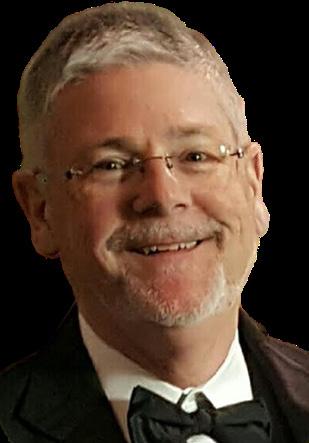



34 ala breve
Dr. Phil Wilson, President
Dr. Travis Bender, President-Elect
Dr. Rob Lyda, Immediate Past President
Heather Holmes, Recording Secretary
Lori Hart, ABA President
Amanda Slay, AVA President
Jordan Kirchner Ford, AOA President
Alicia Luttrell, Elem/Gen President
Stephen Foster, HED President
JP Aufdemorte, AL cNAfME President
Dr. Meghan Merciers, AL cNAfME Advisor
Andy Meadows, ALSDE Arts Education Specialist
Joey Harbison, Industry Representative
Pat Stegall, Treasurer/Registrar
Dr. Russell Logan, Executive Director David Raney, Assistant Executive Director
Garry Taylor, Editor

‣ Generous Scholarships Available for Music Majors and Minors
‣ All members of the Jaguar Marching Band receive a scholarship
‣ Music and Jaguar Marching Band scholarships are stackable with other USA Academic Awards
Audition Dates
January 6, 2024
February 3, 2024
March 16, 2024

April 6, 2024
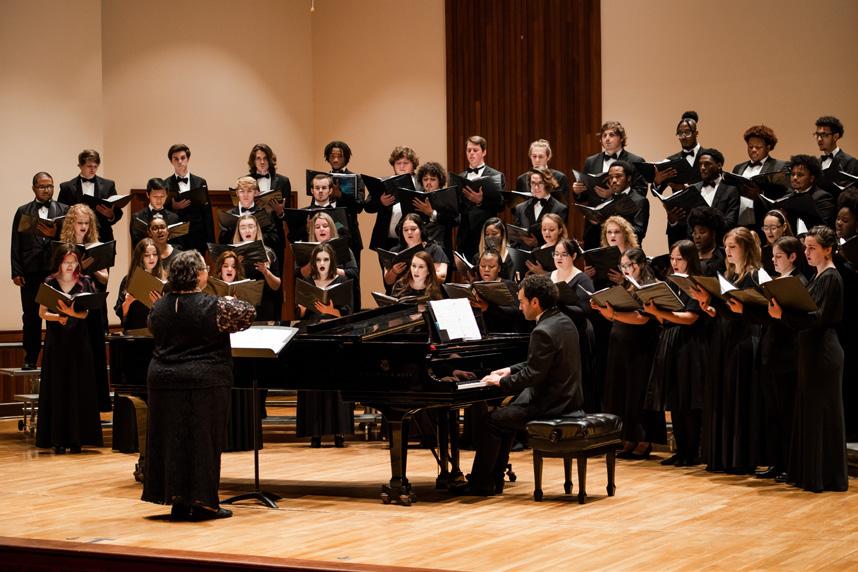

USA
October 14, 2023
South Alabama Marching Band Championships
November 11, 2023
Jaguar Marching Honor Band
December 8-10, 2023 USA Concert Honor Band

Degree Programs
BM in Music Education

BM in Performance
BM with Elective Studies in Music Business
BM with Elective Studies in Specific Outside Fields
MM in Music Education
MM in Performance
MM in Collaborative Keyboard Music Minor


May/June 2024 University of South Alabama, Department of Music | LPAC 1072 5751 USA Drive South Mobile AL 36688 | 251-460-6136 | usamusic@southalabama.edu www.southalabama.edu/music | facebook.com/southalabamamusic
View Audition Requirements visit southalabama.edu/music or jaguarmarchingband.org
To
offers in-state tuition to all out-of-state students awarded an admission scholarship for academic merit at the time of admission
Selecting a Saxophone for Classical and Jazz Performance
By Tracy Heavner
Introduction
There are many brands of saxophones currently being produced varying greatly in quality and price. Within their brand, most saxophone manufacturers also produce several different models to meet the needs of performers at various stages of development. Student models, designed for beginning saxophonists, are the least expensive but also contain the least amount of craftsmanship. Intermediate models, designed for advancing performers, are more expensive because they are made using better materials, more craftsmanship, and contain a few extra features. Professional models, used mainly by advanced saxophonists, are the most expensive and are made using the best materials. They also contain the most craftsmanship and are equipped with extra features not included on other less expensive models.
A majority of saxophonists learn to play using a student model but as they improve, they upgrade to an intermediate instrument. Some saxophonists improve to the point that they consider purchasing a professional quality instrument dependent upon their budget and performance goals.
When selecting a saxophone to purchase, some factors to consider are the instrument’s tone quality, intonation, response, durability, and price. Recommendations from saxophone teachers as well as professional performers are also important factors to consider when determining which saxophone would be the best choice for classical and jazz performance.
Popular Saxophone Brands and Models
Although there are many saxophone brands used by professional saxophonists, the two most popular are Selmer and Yamaha. Selmer saxophones have a long tradition as being the favorite of many professional
performers, especially the Selmer Mark VI model, which was manufactured from 1954 through 1973. Currently, Selmer’s two highest quality instruments are the Selmer Paris Supreme and Selmer Paris Signature. These instruments are used by classical and jazz saxophonists alike and are excellent professional instruments.
In recent years, the Yamaha brand has become very popular with upcoming performers and even some seasoned Selmer artists. Yamaha also produces two professional quality instruments, one designed primarily for classical performers and the other for jazz. The Yamaha Custom 875 EX II saxophone is a professional model saxophone that produces a rich, dark tone that is excellent for performing classical music. For performing in the jazz style, Yamaha produces the Yamaha 82 Z II model, which has a brighter tone and is endorsed by many jazz saxophonists. In addition to Selmer and Yamaha, several other saxophone brands that have reached a level of popularity, especially among jazz saxophonists, are Yanagisawa, Keilwerth, and Cannonball.
While some saxophonists can own two saxophones, one dedicated to classical performance and the other for jazz, due to a variety of reasons, most saxophonists perform on only one saxophone. However, by modifying tone quality through embouchure adjustment and careful selection of mouthpieces, ligatures, and reeds, saxophonists can usually make the necessary changes needed to perform in a variety of diverse musical styles using the same instrument.
Saxophone Finishes
In addition to the brand and model, another factor to consider when selecting a saxophone is the finish. The finish is a coating used to cover the bare brass of the saxophone, protecting it
from the elements and also providing a more appealing appearance.
The type of finish will also affect the tone. In addition to protecting the instrument and giving it a beautiful look, the finish also restricts the natural resonance of the brass and as a result, darkens the tone. Saxophones with the brightest tone are usually coated with no finish, which allows the brass to resonate freely. As a result, these instruments are very popular with jazz and commercial saxophonists even though their appearance may not be as appealing as other finished saxophones.

When ranking the effect of finishes on tone quality, performers will discover that saxophones with a lacquer finish usually have the brightest tone, followed by black lacquer (it is thicker than other lacquered finishes), silver plated, and finally gold plated. Saxophones finished in gold plating, which is the thickest saxophone finish and also the most expensive, will usually have the darkest tone with all other factors remaining equal.
36 ala breve
Cannonball Alto Saxophone No Finish


When selecting a saxophone finish, both the appearance and tonal effect should be considered. However, saxophonists who choose a finish based more on appearance rather than tone quality can still influence the brightness or darkness of their tone. By adjusting the embouchure and selecting the appropriate mouthpiece, ligature and reed, saxophonists can brighten or darken their tone, fine-tuning it for each performance situation.
Choosing a Specific Saxophone
When selecting a saxophone, performers should research various brands, models, and finishes using the Internet, learn about equipment used by top professional saxophonists, get recommendations from saxophone
teachers, and finally test play a variety of saxophones at larger music stores that have them in stock.
When the saxophone brand, model, and finish have been decided, it is time to choose the specific instrument to purchase. Theoretically, saxophones of the same brand, model, and finish should play identically to each other but unfortunately, this is not the case. Depending upon the brand and model, there can be quite a difference between individual instruments. The only way to find the best instrument is to test play several identical saxophones using the same mouthpiece, ligature, and reed. Hopefully, a local music store will have several saxophones to choose from and practice rooms available to test-play them.
If a local store does not have the desired saxophones in stock, some online instrument companies may ship several instruments at once for individuals to try for a short time.
Although this is not the most convenient way to select an instrument, serious saxophonists should always have several instruments to choose from.
When several identical instruments have been acquired, each should be test played for tone, intonation, and response. When playing each instrument, saxophonists should listen carefully to see which instrument has the best tone and also check the intonation throughout the entire range of the instrument using a tuner. Although no saxophone is built perfectly in tune, only minor embouchure adjustments should be necessary to correct notes that are out of tune. Saxophonists should also check the instrument for response in the low, middle, high, and altissimo registers.
If possible, each instrument should be recorded while being test played. It is often easier to determine which instrument sounds best using a recording since this allows performers to focus their full attention on each example rather than trying to play and listen at the same time. Often if three saxophones are tested, one will stand out as being the worst and can be easily eliminated. However, the other two instruments may be very close in playing characteristics. In this situation, it may take several
more test plays to determine which instrument is best. In some cases, it may be obvious that one instrument plays far better than the other two making the choice of which instrument to purchase a simple one.
If a satisfactory instrument is found at a local store but the price is higher than buying the same instrument online, the store manager should be asked if the online price can be matched. Many times, the local store will sell the instrument for the discounted online price.
Summary
When selecting a saxophone for classical and jazz performance, tone quality, intonation, response, durability and price along with recommendations from saxophone teachers as well as professional performers are factors that should be carefully considered. After the saxophone brand, model and finish have been determined through consideration of these factors, the specific saxophone can be discovered by carefully play testing several identical instruments. Through diligence, patience, and by following these suggestions, both classical and jazz saxophonists should be able to select the best saxophone for their particular performance needs.

Dr. Tracy Heavner is an internationally renowned music educator and distinguished performance artist having performed in more than fifteen countries on five continents as an artist for Cannonball, D’Addario and Jody Jazz Music Corporations. Dr. Heavner is a professor of saxophone, music education and jazz studies at the University of South Alabama where he has taught for the past twenty-nine years. He has published over 100 pedagogy articles in music journals and also authored two books. His most recent book is entitled Saxophone Secrets: 60 Performance Strategies for the Advanced Saxophonist published by the Rowan & Littlefield Publishing Group.
May/June 2024 37
Cannonball Alto Saxophone Silver Plated Finish
Cannonball Alto Saxophone Gold Plated Finish
General Music Reviews
by Jason Jackson
Great Big Things
by Kate Hoefler, illustrated by Noah Klocek
© 2017 Clarion Books
https://bit.ly/gbthings
This is a book that caught me on the last page and made my eyes get a little misty.
In this quiet, gentle story, a single mouse travels the world through the vast desert, deep canyon, wide ocean, and frozen fields to deliver a simple crumb to a friend. When questioned about the great big journey to deliver the crumb, the mouse simply deems them “small things” because “it’s a great big thing to love someone.”
The story is simple but deeply moving and the illustrations are absolutely breathtaking. Several pages only have two or three words. A culminating class discussion could be about bravery, persistence, and facing obstacles for people you care about. Or, discuss the mouse-friend’s perspective and talk about having gratitude for the challenges that go into providing us with what merely seem like “small things”. There are lots of directions you can take with this story.
This book is going on my list to turn into a program someday. Inserting a song related to each obstacle the mouse faces on the journey would be a great starting place. A song about a train, the forest, a river, the ocean, a mountain…. Add some creative or choreographed movement for the sunset and sunrise. Add some improvised sound effects for wind, rain, a waterfall…. Have a recurring musical motif, physical object, or both to represent the crumb as the mouse carries it through the story. It’s a hit in the making!


Jason Jackson teaches K-6 general music at Daphne East Elementary School and is President-Elect of the Elementary Division
38 ala breve
THE SIGNIFICANCE OF BORDUNS
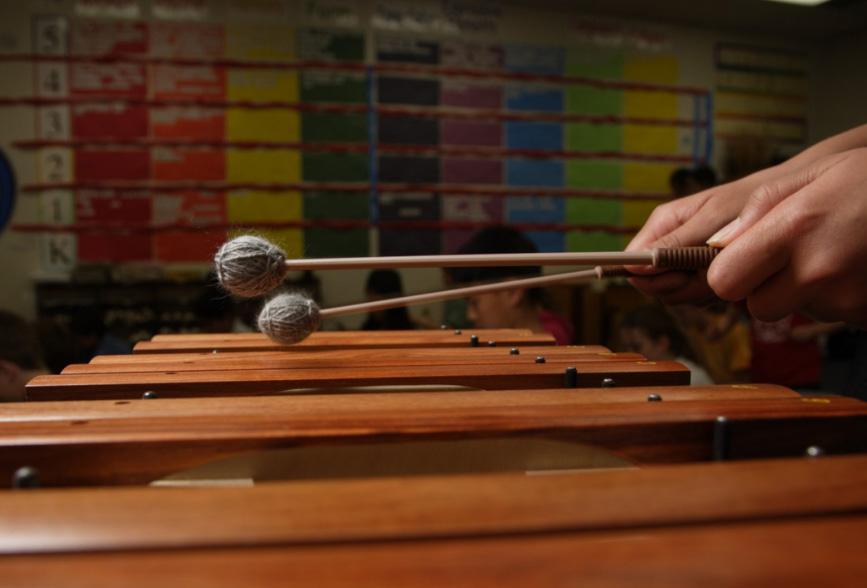
Borduns, also known as drone notes or pedal tones, hold significant importance in music education, spanning various musical traditions and genres. A staple of the Orff school of teaching, these sustained, continuous sounds, whether a single pitch or a simple harmonic pattern, serve as background accompaniments, shaping the harmonic and rhythmic structure of a piece. With historical roots dating back to medieval and Renaissance music, borduns are integral to diverse cultures and traditions, including folk, classical, and world music.
In the realm of elementary music education, borduns play a crucial role in developing musical skills. They aid in ear training by emphasizing pitch recognition and harmonic relationships, establishing rhythmic stability, and improving intonation as students align their pitches with a fixed reference point. This versatile tool is adaptable across different musical traditions, fostering an appreciation for global musical diversity and encouraging exploration.
The first kind of bordun that is most commonly used is a simple bordun, or chord bordun. This is when the students will play (typically on Orff percussion instruments) scale degrees 1 and 5, or “doh” and “sol”. They will play both notes simultaneously on strong beats, providing both a rhythmic and harmonic drone for the accompanying melody being sung or played by other students. The second type of bordun is known as a broken bordun. This is where you
by Mason Mays
play the first scale degree on the strong beat and the fifth scale degree on the weak beat. This results in a basic I-V chord progression, which helps introduce the concept of chord and harmonic progression to students.
Another form of bordun is the octave bordun, in which students will jump octaves when playing. This could also mean from playing 1 and 5 to playing 5 and 1. This form of bordun helps students identify the difference between the intervals of a fourth and fifth.
Overall, a bordun can teach many concepts in music education, from theory, to rhythm, to pitch recognition. It is clear to see why the Orff method is so keen on using them to help teach melodies and songs, and why they are a staple among elementary music classrooms across the globe.
Links to podcasts: https://on.soundcloud.com/QQTdr https://on.soundcloud.com/ZMPqE https://on.soundcloud.com/TUrEr
Mason Mays is a graduate student at UAB

May/June 2024 39
Band Music Reviews
As the end of the school year approaches, I would like to share a few pieces that you might consider programming next year. I hope you enjoy listening and potentially playing them!
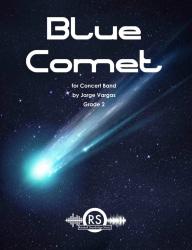
Blue Comet (2022) is a grade 2 work by Jorge Vargas (www. jvargasmusic.com). Vargas is a band director at Memorial Junior High in Eagle Pass, TX, where he teaches beginning band, concert band, and Mariachi. He holds degrees from The University of Texas-San Antonio and Lamar University.
From the composer: “I have always
been fascinated by outer space-The stars, solar systems, and galaxies. Many of my music is influenced by space, and this piece is no different. Picture a comet streaking through the night sky, as a faint, blue light surrounds it and lingers long after the comet disappears from view. A blue comet.”
This two-minute work is written in 4/4 time with a key signature of Eb Major (C minor) throughout. There is minimal use of accidentals and is a great piece for teaching syncopated rhythms. It also contains rhythmic dialogue between voices and some independent parts. Instrumental ranges are very comfortable for all instruments and can be performed with 8-12 percussionists. This exciting, energetic work would be a great addition to any concert program.
A recording and score of Blue Comet can be found at https://www.randallstandridge. com/music-catalog/concert_band_ music_2/Blue%20Comet.
Burn After Reading (2023) is a grade 3 piece by Andrew David Perkins (www.andrewdavidperkins. com). Perkins is a GRAMMYnominated music educator with degrees from the Berklee College of
by Jeremy Stovall
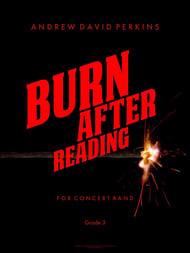
Music, the University of Michigan, and Michigan State University. This piece was commissioned by the Cooper Middle School (VA) Symphonic Band for their performance at the Midwest Band and Orchestra Clinic.
Intense, driving rhythms characterize this three-minute work. It is written in 3/4 and 4/4 throughout with a key signature of Bb Major (G minor). It utilizes some use of syncopation and frequent use of accidentals. One highlight is a fugue-like section in the middle of the piece. Intense percussion parts utilize anywhere from 7-11 percussionists. This is
40 ala breve
an audience-friendly piece while maintaining accessible technique and instrumental ranges.
A recording and score of Burn After Reading can be found at https://www.andrewdavidperkins. com/store/p68/BURN_AFTER_ READING_%28Gr.3%29.html.
Pieces of Glass (2019) is a grade 3.5 work by Leslie Gilreath (www. lesliegilreath.com). He is the Director of Bands at Summerville High School (SC) and a graduate of Furman University. This minimaliststyle piece is an homage to composer Philip Glass.
The majority of this 3:30 work is written in 5/4 with some meter changes. It is characterized by lyrical passages on top of rhythmic ostinatos. It also contains Doppler effects in dynamics, rhythmic layering, and several instances of syncopation. The percussion parts can be played by 6-10 percussionists

who serve as a metronome throughout the majority of the piece by playing constant underlying rhythmic motor elements. This gives the ensemble a sense of comfort with a steady tempo. Instrumental ranges are very comfortable for all instruments. This would be a great addition to a spring concert program.
A recording and score of Pieces of Glass can be found at the following link:
https://www.youtube.com/ watch?v=eaogI4Vvvow.
Best of luck to everyone as we all finish out the school year. I hope you all have a safe and restful summer. Please reach out if I can ever be of assistance!

Dr. Jeremy Stovall Assistant Director of Bands Associate Professor Jacksonville State University jstovall@jsu.edu

May/June 2024 41
Choral Music Reviews
by William Powell
San’bonani/Namhla Kudibene (SATB, 2 tenor solos; also available for TTBB)
arr. by Michael Barrett
Traditional IsiZulu and IsiXhosa songs
Santa Barbara Music Publishing, Inc.
SBMP 1422 (satb); SBMP 1499 (ttbb)
$2.10
Duration: Approximately 3:39
The pairing of these two songs from South Africa provide an exciting contrast within the span of the medley. San’bonani is a traditional Zulu greeting (“Hello…are you well?), while Namhla Kudibene includes a line of text that references responding to the threat of war. Arranger Michael Barrett voices the harmonies in a manner that represents traditional South African music, and it is especially well crafted in the TTBB setting. The score includes translations, pronunciations, descriptions, and performance suggestions. Although there are no instrumental parts provided in the score, the arranger suggests an online video of his group, Tuks Camerata (University of Praetoria) “for an authentic performance.” The viewer will observe how to incorporate African percussion instruments and appropriate movement. There are also great resources on the publisher’s website including a biography of the arranger. This arrangement seems well suited for junior high through young adult singers.
I Am Not Yours (SSA and piano with violin)
by Victor C. Johnson
Text
by Sara Teasdale (1884-1933)
Choristers Guild
CGE144
$2.10
Duration: Approximately 4:15
It’s no secret that I am a big fan of composer-arranger Victor C. Johnson. I am also a fan of poet Sara Teasdale. Combine the two, and the result is a compelling text set to a beautifully harmonized melody. Teasdale’s poetry stirs up emotions that the reader or listener might not even be aware exists at a surface level. Johnson’s ability to set that poetry to music is a testament to his great skill and creativity. Additionally, his vast experience with treble voices makes this setting one that, I believe, works quite well with adolescent and adult voices. The violin part is provided on the last pages of the choral score, but it is not written within the choral score. However, the piano accompaniment is involved and interesting, providing enough support for an ensemble that might not have access to a violinist.
Swingle Song (SATB)
by Darmon Meader
Carl Fischer
CM8908
$2.75
Duration: Approximately 2:05
Those who recognize the name Darmon Meader or The Swingle Singers know that they are in store for some vocal jazz. For choirs that seek to add vocal jazz to their repertoire, this is a good place to start.
According to the composer, Swingle Song is to be sung in “Swingle Singers swing style.” The only text is “doo doo, doo bah doo, doo bah doo…” The swinging melody gets sung by most voice parts at some point within the song, including the bass voice which also mimics an upright bass for most of the composition. It lends itself to finger snapping, especially when the “bluesy groove” section begins. While this song might not be accessible to beginning choirs, it appears to be a work that is accessible to most high school choirs and older.
 William Powell Director of Choral Activities Auburn University
William Powell Director of Choral Activities Auburn University
42 ala breve


Teacher Profile

Chuck Eady
Editor’s Note: Each Teacher Profile spotlights a music educator from across the full spectrum of AMEA - new teachers, experienced teachers, retired teachers, and teachers from each of AMEA’s different divisions. This issue features Chuck Eady, a retired band director who lives in Pelham.
Briefly tell us about your current position, how long you’ve been there, and a little about your schedule.
I retired as a full-time band director in 2019 after 42 years. Have been an adjunct private instructor at Bumpus Middle School in Hoover for the past three years or so.
Tell us about your background – hometown, college, family, etc.
I grew up in Albany, GA, and am a graduate of Florida State University, where I earned my Bachelor’s Degree in Instrumental Music Education. I also have a Masters Degree from Memphis State University. My wife Lee and I have been married for 47 years and have three sons and eleven grandchildren.
Why did you decide on a career in music education?
My Junior High Band director turned me on to music through his passion and demand for excellence in music. I knew I wanted what he had.

Who are some of your teachers/colleagues that you would consider mentors and why?
Dr. Dale Grabill at Albany Junior College in Albany, GA was an inspiring influence on the beginning of my music studies in college. Also, Dr. Manley Whitcomb, my conducting professor at the Florida State School of Music was a fountain of musical knowledge and wisdom while I studied at FSU.
Name one accomplishment that fills you with pride so far in your career.
One of the things I am most proud of is the number of former students I have taught who are presently music teachers in Elementary, Middle School, High School, and College. I also have several who are professional performers.
What would your students be surprised to find out about you?
I used to be an avid quail hunter and bass fisherman and at one time raised quarter horses.
How do you spend your summer breaks?
At softball and baseball parks watching my grandchildren.
Are you involved in other music-related activities in addition to your teaching position? If so, please explain.
I am the Worship Leader at Grace Presbyterian Church in Hoover, AL.
How about interests or hobbies not related to your teaching position?
My number one hobby is being “Papa” to eleven grandchildren.
May/June 2024 45
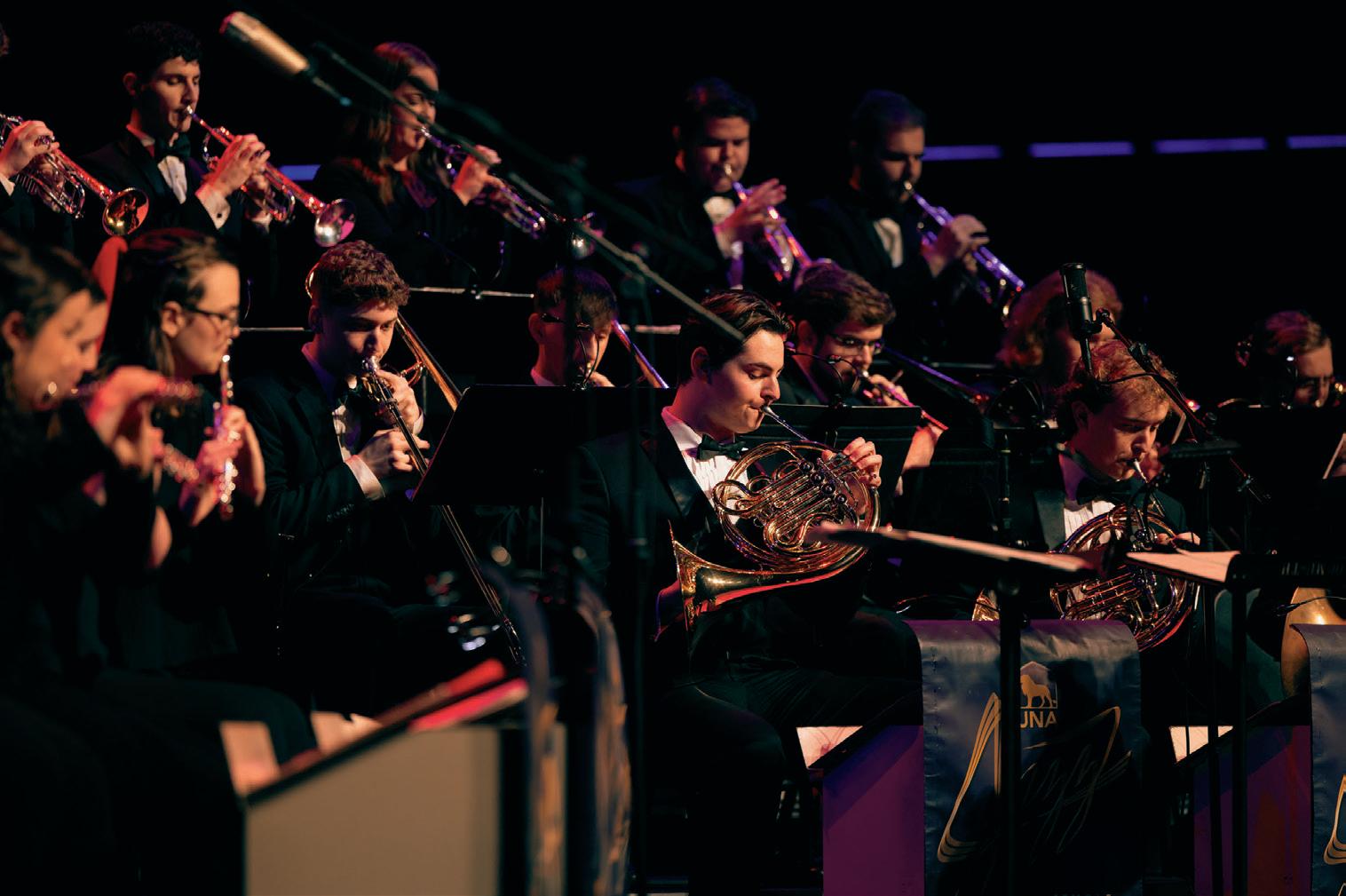
The University of North Alabama Department of Music offers scholarships to qualified music majors and minors in all instrumental, vocal, and piano programs through
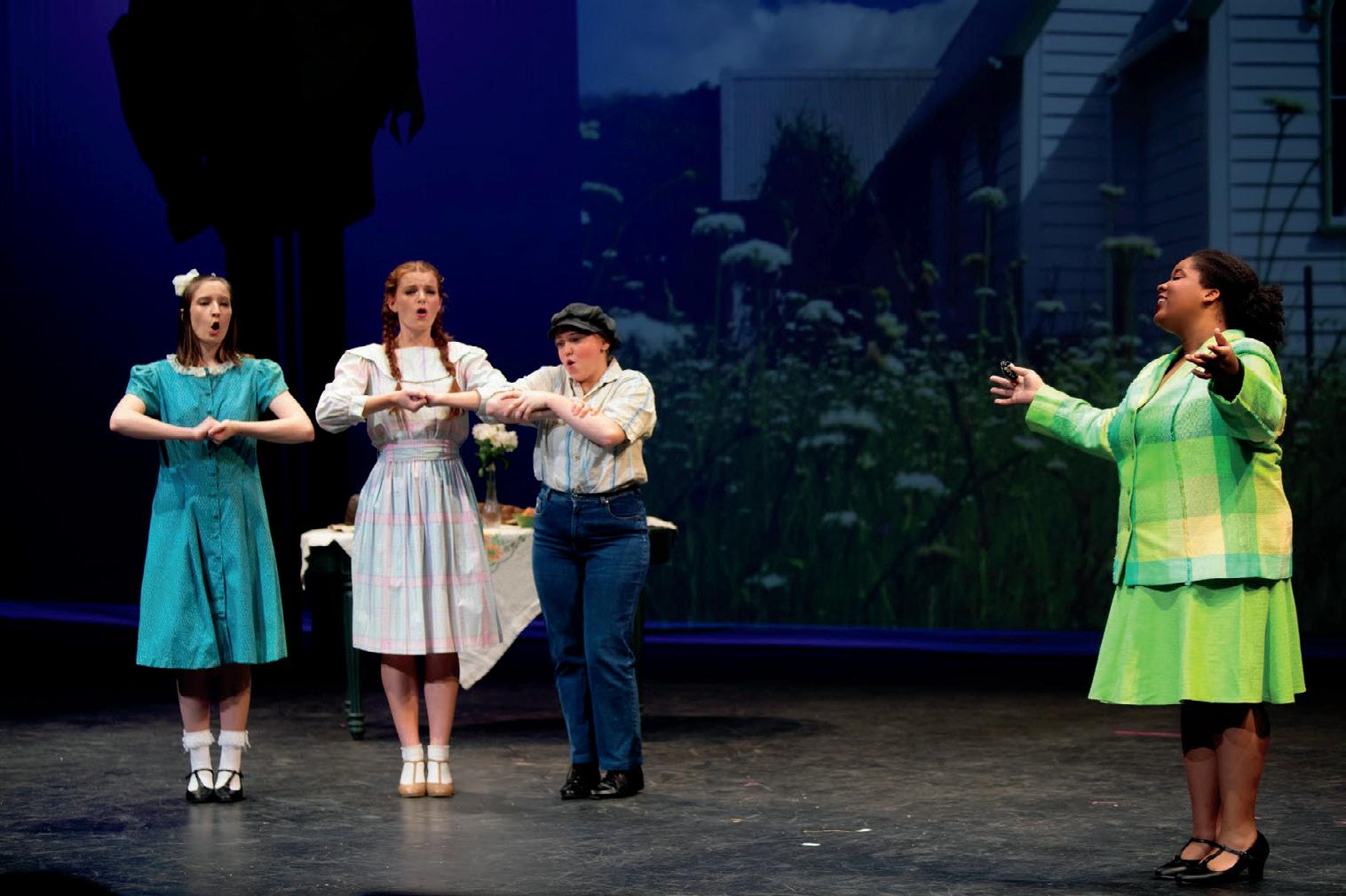
Degrees Degrees


Ensembles may be eligible for a rdless of their academic major.
ntact us
ic | 256.765.4375 u | @unamusic1


Bachelor of Music in Performance
Bachelor of in Performance
Bachelor of Music in Performance
IInstrumental nstrumental Instrumental
Piano Piano Piano
Vocal Vocal Vocal
Minor Minor Minor Music Music Music
Certificates Certificates Certificates
Bachelor of Arts or Science in Music
Bachelor of Arts or Science in Music
Bachelor of Arts or Science in Music
IInstrumental nstrumental Instrumental
Vocal / Choral Vocal / Choral Vocal / Choral
Musical Theatre Musical Theatre Musical Theatre Percussion Specialist Percussion Specialist Specialist
Bachelor of Science in Education
Bachelor of Science in Education
Bachelor of Science in Education
Choral Music, P-12 Choral P-12 Choral Music, P-12
Instrumental Music, P-12 Instrumental Music, P-12 Instrumental Music, P-12


 Dr. Andy Nevala Director of Jazz Studies
Jacksonville State University
Dr. Andy Nevala Director of Jazz Studies
Jacksonville State University

There are many things to prepare when taking your group to a festival or competition. There’s the logistics (how do we get there and back), there’s the students (make sure you bring your instrument and music little Timmy!), and there’s the playing of the music. What do I play that best shows the strengths of my ensemble? What do the judges/clinicians expect to hear from my group, compared to other schools of similar size performing right before or after my group? All of these things can be overwhelming at first, but let’s break it down to the nuts and bolts of what’s really important.
When I adjudicate these events, I’m looking/listening for several things. The first is a balanced program. At a Jazz Festival, at least one of your selections MUST be a swing selection. If your group comes out of the gates swinging hard, I’m open to any other styles/feels that follow, because you have shown that you have taught your ensemble the most important element in Jazz Performance: how to swing. The chart can be any grade level; it’s the concept of the “Jazz Triplet” I’m listening for. After that, play a funk, Latin, or ballad, feature your best kids, and do what you please - you showed me you know what you’re doing with your swing chart selection and preparation and I’m ready to hear your artistic musical choices.
Preparing Your Ensemble for a Festival
The order of tunes is also important. Open with something strong, like a Basie swing. Follow that with a ballad or lighter selection, maybe featuring one of your best players. Follow that with a contrasting choice, a Latin number, Funk, or contemporary selection. Close with your best, high-energy choice that really showcases what the band can do. I have to wait to program concerts until after we have rehearsed and played together for a few weeks, so I can see where the strengths and weaknesses of the ensemble are, and then I pick songs based on that. I come into each semester with about 10 charts, and we end up playing 5 on the concert.
The next thing I listen for are articulations. Are the short notes all short? Are the long notes all long? Is everyone playing them the same way? Are the saxes using backaccent articulations (tonguing the upbeats)? Are the releases together? Articulations are one of the biggest keys to getting a band that sounds like they are playing together. Then I’m listening for balance (can I hear all the parts), dynamics (does your group only play one dynamic, Fortissimo), and time (are we rushing/dragging, or even agreeing on the rushing/ dragging).
I’ll then focus on the rhythm section. Are the bass player and drummer together? Is the drummer’s ride cymbal quarter note pulse lining up with the bass player’s walking bass line? What are the piano and guitar playing? Are they comping at the same time? Do I hear any jazz chords from either of them? On the Latin styles, are the instruments associated with those styles being played together the right way? Do a little research for your rhythm section and play recordings of the different feels and styles you want them to play.
May/June 2024 47
Photo by Peter Okwara on Unsplash
Jazz Collective
Christopher Kozak University of Alabama Director of Jazz Studies

When adjudicating for Jazz Festivals, I look for the obvious things that we are all asked to evaluate a performing ensemble. Can the band swing? How cohesive is the sound? How is the overall intonation of the band or sections? Can they keep time without speeding up or slowing down? Are they playing the style and feel correctly? Does the band have soloists and if so, do they play the style well? When soloing, are they navigating the changes well? Does the attire they wear reflect their professionalism? Is the repertoire they are playing in line with the expectations of the festival? Those are only a few of several things I look for and it varies from band to band and level of playing. Any response to those questions can affect the score rating I provide but at best will trigger commentary that will allow your group to improve. What we base our evaluations on is the standard set by the Master’s of years past and should be reflected to some degree in your band’s presentation. The best examples of our expectations can be seen and heard in photographs, videos, and recordings of Duke Ellington, Count Basie, Tommy Dorsey, and Glenn Miller Orchestras just to name a few. Make sure your students see and hear as much of those bands and that genre as possible as it sets the stage for what they should be striving for!
One thing I’d like to mention is to understand where your band lies in the realm of the genre. It hasn’t happened recently but there have been festivals I’ve adjudicated or attended where a band would show up that did not fit the criteria of what is expected at a Jazz Festival. For example: While your Show Band may have a great level 1 arrangement of a Stevie Wonder hit (don’t get me wrong I LOVE the music of Steve Wonder) with choreography, no solos, and some kind of theatrics, it may not fit into the criteria of the festival where the adjudication relies on nuanced factors such as musicality and the minute details of dynamics, phrasing, articulations, and attacks/releases. Those bands are great gateways into more focused playing and are an excellent outlet for your students to get acquainted with performing in front of their peers and audience but that type of group would be best suited to a non-adjudicated performance venue where entertainment takes precedence. While music should certainly be fun, we can’t overlook the pedagogical importance of having our students play challenging, historically significant repertoire as it relates to the genre, especially if you are calling your group a “Jazz Band” or “Jazz Ensemble.” Choosing that more focused repertoire can assist in getting your most talented students moving to the next level of playing more serious literature and puts higher demands on the musicians to become better at their craft. A few places to look for what repertoire could be considered acceptable at festivals can be found at www.alfred.com/festival-jazz/b/ (it breaks down some repertoire for a few states and is a great place to see what is expected elsewhere for festivals and competitions) and www.ejazzlines.com under Festival Charts.
There are other resources but both of these have selected charts that have been used or are recommended for festivals and competitions.
While every festival organization has its own requirements, here are a few things that I really like to see from a band that attends an adjudicated festival:
• Printed scores of all selected pieces for all judges whether they are required or not
• Organized entrance and exits from stages to expedite play time for all bands
• Appropriate difficulty level of charts that suit the level in the band
• The repertoire should be in line with the expectations of the festival. It may be a good idea to ask for programs from the organizers from years past to not pick the same charts or use them as a guide of what to select.
• Program the pace of your selections to draw the audience and judges in. Don’t start with your showstopper or have all burners. Have a varied program to show the diverse styles your band can play and it can keep from burning out chops too early.
• Encourage your soloists who are reading a solo (not improvising) to try to either memorize the solo or embellish what is there beyond the page to make it theirs. Too often I’ll hear someone play a written solo and it sounds like they are reading it. It’s amazing what getting away from the page can do for a performance!
While this may be somewhat controversial, as a rule of thumb, I do not allow band members in my groups to wear hats, Jazz T-shirts (I’m not talking about uniform-type outfits or shirts for your band program but you know the ones… with Miles Davis’s face covering the entire front of the shirt,) or sunglasses while performing. Sunglasses in particular, as seeing the eyes of all of the players in the band is crucial for communication. Besides, it doesn’t look as cool as they think. Professionalism is key and your group will be taken more seriously if you present yourselves as such.
We hope you all at least try to get your bands to some adjudicated festivals. Healthy competition can motivate your students to achieve great things. The new Alabama Music Performance Assessment for Jazz through the ABA is a great place to see where your band is at and it’s right here! As always, feel free to contact any one of the directors and contributors to this article with any questions, flowers, or brickbats. We love hearing from you!
48 ala breve
Dr. Steve Roberts Director of Jazz Studies
University of Alabama at Birmingham

1. Warm-up – While there are many ways to warm up your group at a jazz festival, understand that as soon as you step on the stage you are performing. The judges may not be explicitly scoring you on your warm-up but this first impression can affect how they see your group. Going around holding a tuner in front of each student musician is generally a waste of time and gives the group a beginner look. If you don’t have a solid warm-up, reach out to a local university and see what they are doing or if they have any suggestions for you. Generally, you want to work on swing style, articulation, and ensemble precision in the warm-up.
2. Programming - As my colleagues mention, program a diverse selection for your group with a nod to tradition. Pick tunes that fit your band well and are fun to learn, but understand that the root of the music is in the swing tradition and judges will generally want to see young jazz musicians being grounded in the tradition of Basie, Ellington, etc. From there, it is a good idea to program a Latin tune, a ballad, and then something more modern like a funk chart.
3. Listening - When preparing your charts, make sure the students (and the director!) have listened to the traditional versions of the chart. The judges will have a preset idea of what significant literature should sound like, and if a band vastly departs from that tradition it is unlikely it will be a positive thing in scoring.
4. Soloing - Written-out solos are ok if they are performed with good style, but an improvised solo will be valued much more. Improvisation is at the heart of jazz, and while written-out solos may sound good and aid the student in developing style, they strip the student of the core responsibility of a jazz artist, to improvise. Find solo sections that aren’t too difficult (stay in 1 or 2 keys) and empower your students to explore melodies over the chord changes. If you are unsure how to prepare your students for improvisation please reach out to one of us or find another professional to help guide you. I am always happy to help band directors in this mission!
5. Overall - the purpose of a jazz festival is to educate and inspire students and directors. Show up early and stick around late so that everyone can hear the other groups, especially the ones that are better. While this is often a competitive environment, encourage students to interact with other bands, share ideas, and even jam together if given the opportunity. These will be their future colleagues and could end up being bandmates, and often the best education a student can get is from someone their own age.
Dr. Dave Camwell Professor of Music
Troy University
My colleagues Andy, Chris, and Steve have listed many accurate things to consider when bringing your band to a festival. In addition to the excellent points listed in this article, I would recommend considering the following items:

1. SOLOISTS - ACKNOWLEDGE YOUR AUDIENCE!
Musical performances are often the most gratifying when there is communication between the audience and the performer. This is particularly true when a soloist finishes their improvised solo, and the audience claps their appreciation. However, I often see young musicians give no acknowledgement at all to the audience. There doesn’t need to be a grand physical gesture, but I would suggest the etiquette of at least smiling and giving a small nod or bow. Music is ideally about bringing people together, and students should give a show of thanks to the audience that has just recognized their efforts.
2. MAKE SURE YOU ARE IN TUNE! Your band will likely be in a warm-up room for 30 minutes or more before your performance. Amongst other necessary things, make sure that individual and ensemble intonation is addressed during this time. Being in tune is a critical component to every type of ensemble, and in my opinion, more time should be spent on students knowing their intonation tendencies as well as how to set up their instruments (mouthpiece placement, etc.) that will give them the best chance to play in tune. Even the right notes, rhythms, style, and articulations will not be nearly as effective if your band’s intonation is poor.
3. POSTURE: Not only is this important to play at your best, but good posture also looks better and gives off positive body language to the audience. I recently hosted a jazz festival and observed several students with very poor posture, which lowered the look and performance level of the ensemble. When in a performance situation of any kind, remember that you are representing your school, your ensemble, and yourself to many people in the audience who may be viewing you for the first time. Give your maximum effort to look and sound as good as possible. Students can slump on their couch when home; however, the stage is a place for maximum effort because the rewards are absolutely worth it! Make sure your students watch a video recording of the ensemble following the performance and look for the quality of and consistency of the body language amongst the band.
May/June 2024 49
AMEA Division Events 2023 - 2024
Alabama Vocal Association
8, 2023
All-State Auditions
OCS/ME
Solo & Ensemble
November 1-2, 2023
November 3, 2023
November 6, 2023
November 7, 2023
November 8-9, 2023
District I: November 30
District II: November 14
District III: November 28
District IV: November 28
District V: November 27
University of
Christ Episcopal Church, Tuscaloosa
Gadsden City High School
Spring Hill Baptist Church, Mobile
Saint James School, Montgomery
Mayfair Church of Christ, Huntsville
State Choral Performance Assessment
District I: March 20
District II: April 4-5
District III: March 13-15
District IV: February 16
District V: February 22-23
District VI: April 2
District VII: October 17
District VII: March 19
District I: March 20
District I: March 21
District II: April 4-5
District III: March 13-15
District IV: April 12
District V: March 6-7
District VI: April 2
District VII: March 19
University of North Alabama
University of Alabama
Hope Church Gardendale
Jacksonville State University
First Baptist Church Huntsville
Tallassee High School
Spring Hill Baptist Church, Mobile
Spring Hill Baptist Church, Mobile
University of North Alabama
First Baptist Church Decatur
University of Alabama
Hope Church Gardendale
Gadsden City High School
Grissom High School
Tallassee High School
Spring Hill Baptist Church, Mobile
November
AMEA Collegiate Division
50 ala breve
August
East Alabama General Music Workshop Auburn October
2023 Elementary Music Festival Metropolitan Church of God, Birmingham
Elementary/General Division
26, 2023
27,
AOSA Professional Development National Conference Albuquerque, New Mexico
2024 AMEA Professional Development Conference Von Braun Center, Huntsville
2024 National OAKE Conference Chicago, Illinois
2024 Elementary All-State Choir Huntsville, Alabama
29, 2023 Collegiate Summit Troy University January 18-20, 2024 AMEA Professional Development Conference Von Braun Center, Huntsville EVENT DATE LOCATION
September
1-4, 2023
January 18-20,
March 15-17,
March 22,
October
Fall Workshop
Montevallo
Virtual
Virtual
Virtual
Virtual
Virtual
Virtual
Virtual
District VI: November 16
District VII: November 28
District
Alabama Bandmasters Association
District
District
May/June 2024 51
DATE REG. DEADLINE
10/27/2023
1/6/2024
12/5/2023
State Solo Festival Von Braun Center,
April
2024 3/1/2024 All State Festival Von Braun Center, Huntsville April 25-27, 2024 3/1/2024
DISTRICT EVENT LOCATION
Statewide All State Jazz Recordings http://www.alaband.org/ Oct. 31-Nov. 14, 2023
AMEA Conference Von Braun Center, Huntsville January 18-20, 2024
All-State Jazz Festival Von Braun Center, Huntsville January 18-20, 2024
All
Huntsville
24,
8/14/2024
12/22/2023
1 District Fall Meeting James Clemons High School, Madison August 21, 2023
All State/ District HB Auditions Huntsville High School, Huntsville January 26-27, 2024
Hartselle
February 27-29, 2024 2/6/2024
James Clemons High School, Madison March
2024 2/13/2024
Liberty
April
3/16/2024
May
4/13/2024
District Honor Band Grissom High School, Huntsville February 16-17, 2024 2/5/2024 MPA #1
High School, Hartselle
MPA #2
5-7,
Solo and Ensemble #1
Middle School, Madison
6th, 2024
Solo and Ensemble #2 Priceville High School, Decatur
4th, 2024
Spring Meeting
All
Albertville
January
12/22/2023
High School, Albertville February 9 - 10, 2024 2/2/24 MPA Gadsden City High School, Gadsden February 27 - March 1, 2024 2/2/24 Solo and Ensemble Boaz High School, Boaz May 4, 2024 4/5/23
District 2 District Fall Meeting Gadsden City High School, Gadsden August 22, 2023
State Auditions
High School, Albertville
27, 2024
District Honor Band Albertville
3 District Fall Meeting Zoom Meeting August 22, 2023 All State Auditions Muscle Shoals High School, Muscle Shoals January 27, 2024 12/22/2023 District Honor Band Russellville High School, Russellville February 9-10, 2024 2/2/24 MPA University of North Alabama, Florence March 5-7, 2024 2/12/2024 Solo and Ensemble Muscle Shoals Middle School, Muscle Shoals May 4, 2024 4/12/24
4 District Fall Meeting Oak Mountain High School September 11, 2023 All State Auditions Hoover High School January 27, 2024 12/15/2023 District Honor Band Oak Mountain High School February 23 - 24, 2024 2/5/24 MPA #1 Oak Mountain High School March 4 - 7, 2024 1/12/24 MPA #2 Thompson High School March 11 - 13, 2024 1/12/24 Solo and Ensemble Bumpus Middle School May 4, 2024 4/12/24 District Spring Meeting Oak Mountain High School February 24, 2024
District
5 District Fall Meeting Zoom Meeting August 22, 2023 All State/District HB Auditions Brookwood Middle School January 27, 2024 12/15/2023 District Honor Band Moody Music Building (UA) February 16-17, 2024 2/2/2024 MPA Moody Music Building (UA) March 5-8, 2024 2/13/24 Solo and Ensemble #1 Marbury High School April 11, 2024 3/22/24 Solo and Ensemble #2 Brookwood High School April 13, 2024 3/22/24
6 District Fall Meeting Auburn HS Band Room August 12, 2023 All State Auditions Opelika HS January 27, 2024 12/15/2023 District Honor Band Auburn JHS February 16-17, 2024 2/5/24 MPA Auburn HS February 27-29, 2024 2/8/24 Solo and Ensemble East Samford School April 20, 2024 4/5/24 District 7 District Fall Meeting Barton Academy August 21, 2024 All State Auditions TBA January 27, 2024 12/22/2023 MPA Baker High School March 4-8, 2024 2/2/2023 District Honor Band Daphne High School March 14-15, 2024 2/16/2023 Solo and Ensemble TBA May 4, 2024 4/12/2024 District Spring Meeting TBA May 20, 2024
8 District Fall Meeting TBA August 21, 2023 All State Auditions Coppinville Junior High School January 27, 2024 12/22/2023 MPA Enterprise Performing Arts Center March 5-7, 2024 2/12/24 District Honor Band Enterprise Performing Arts Center March 8-9, 2024 2/12/24 District Spring Meeting Enterprise High School March 8, 2024 Solo and Ensemble #1 W.S. Neal HS May 4, 2024 4/19/24 Solo and Ensemble #2 Houston Academy May 11, 2024 4/19/24
District
District
Article I – Name
The name of this organization shall be the Alabama Music Educators Association, hereinafter designated as AMEA or the Association. This Association shall function as the Alabama unit of NAfME: The National Association for Music Education, hereinafter referred to as NAfME, in accordance with the Constitution and Bylaws of that organization.
Article II – Object
The object of this Association shall be:
1. To effect mutual assistance and the promotion and advancement of music education through educational institutions and other organizations;
2. To encourage music activities among the schools of the state by means of festivals, clinics, workshops, and other related events;
3. To secure greater recognition for music as an integral part of the school curriculum;
4. To encourage the development of post-school music opportunities in each community.
Article III – Membership
Section 1. Active Membership. Active membership in the AMEA with the right to vote and to hold office shall be open to persons engaged in music teaching or other musicrelated educational work in Alabama. Annual dues shall be the amount stipulated for NAfME membership, plus the amount specified in the AMEA Bylaws. Only active members may have voting privileges or hold office.
Section 2. Retired Membership. Retired membership shall be open to former music educators who have retired from teaching, administrative, or research positions in music education and are members of NAfME at the time of retirement. Retired members shall have the same privileges as active members except the right to vote and to hold office.
Section 3. Student Membership.
a. Collegiate membership shall be open to students of music education at the college level who are not employed as full-time teachers. Student members shall have the same privileges as active members except the right to vote and to hold office.
b. Tri-M Music Honor Society Membership. Student membership in the Tri-M Music Honor Society shall be open to high school or junior high students who are enrolled in a school-sponsored music ensemble, of excellent character, exhibit a good attitude toward teachers and fellow students, be cooperative and helpful in their classes, and school community, and maintain a high standard of achievement in music and academic subjects.
Section 4. Industry Membership.
Industry membership shall be open to businesses, ensembles, organizations, colleges, and universities that support the mission of AMEA. This membership shall have the same privileges as active members except the right to vote and to hold elective office.
AMEA Constitution
Updated on 2/20/2024
Section 5. Life Membership
Life Membership in NAfME will be recognized by AMEA and will have all the privileges of Active Membership described in Article III, Section 1.
Section 6. Eligibility.
The decision of the Governing Board regarding the eligibility of any candidate for membership shall be final.
Article IV – Government
Section 1. Authority.
Authority for the management, policies, and actions of the AMEA is vested in the AMEA Governing Board.
Section 2. Officers.
The officers of the AMEA shall be the President, the Past-President, the President-Elect, and the Recording Secretary. The President-Elect and Recording Secretary shall be elected in every even-numbered year.
Section 3. Governing Board.
The Governing Board shall be composed of the President, Past-President, President-Elect, Recording Secretary, the Collegiate (cNAfME) Faculty Advisor, and the President or Chairperson of each of the Divisions.
Ex-officio non-voting members of the Governing Board shall be the Arts Education Specialist of the Alabama State Department of Education, the Editor of Ala Breve Magazine, the Executive Director of the AMEA, the AMEA Assistant Executive Director, the Treasurer/Register appointed by the President, the Industry Member Representative, and the State Collegiate (cNAfME) President. Additional ex-officio, non-voting members of the governing board may be appointed and serve at the discretion of the Governing Board.
Advisory members shall be the Presidents-Elect and/or Vice-Presidents of each of the Divisions and shall serve in a non-voting capacity.
Section 4. Quorum.
A quorum shall consist of a majority of the elected members of the Governing Board or their representatives. Such representatives shall be restricted to the Past-President, President-Elect, and/or Vice-Presidents of the Divisions.
Article V – Elections
Nominating Committee. No later than 60 days before the annual AMEA Professional Development Conference, the President shall appoint a committee to nominate two candidates for the office of President-Elect and two candidates for the office of Recording Secretary. The Committee shall consist of one member from each of the Divisions and one member-at-large who shall be chairperson, none of whom shall be members of the Governing Board. The Nominating Committee shall present its slate at the next general business meeting of the membership, at which time additional nominations may be made from the floor.
Article VI – Meetings
Section I. The Governing Board shall establish the time and dates of all general meetings, business meetings, and conventions.
Section 2. The Governing Board shall meet at the call of the President or upon the joint request of not less than five members of the Board.
Article VII – Funds
Section 1. All monies received from any source whatsoever for Association-sponsored activities shall be turned over to the Executive Director or Treasurer/Registrar and properly receipted.
Section 2. Funds of the Association shall be disbursed by the Executive Director or Treasurer/Registrar in accordance with an annual budget adopted by the Governing Board.
Section 3. There shall be a bi-annual financial review of the Association’s finances by an independent accounting agency. Results of this review shall be published on the Association’s website, www.myamea.org
Article VIII – Committees
Section 1. Standing Committees. Standing committees may be established as needed by the Governing Board. Members of such committees shall be appointed by the President with the approval of the Governing Board. They shall serve during the term of the administration in which they are appointed. The President shall be a voting ex-officio member of all standing committees. AMEA shall include the following standing committees:
a. Nominating Committee – as set forth in Article V.
b. Budget Committee – The Budget Committee shall consist of five members: the President, Past-President, PresidentElect, Treasurer/Registrar, and one member-at-large. The Past-President shall serve as chair. The Executive Director shall serve as a non-voting member. It shall be the responsibility of the Budget Committee to prepare and present an annual budget to the Governing Board for their approval. The budget shall be ready for presentation to the Governing Board at the summer board meeting. After approval, by the Governing Board, it shall be published on the AMEA website by August 31.
Section 2. Ad Hoc Committees. Ad hoc committees shall be appointed by the President as the need arises and shall serve until their specified task is completed, or during the term of the administration in which they are appointed unless otherwise authorized by the Governing Board.
Article IX – Disposition of Assets
Upon dissolution, all of the assets of the Association shall be turned over to such non-profit organizations qualifying as exempt from Federal tax under Section 501 (c) (3) of the Internal Revenue Code of 1954 or any successor provision thereto as the then Governing Board shall select.
Article X – Provision for Divisional Bylaws
Each Division of this Association shall have the right to es-
52 ala breve
tablish bylaws governing its specific organization and activities provided that they are in accord with the articles of this Constitution and the General Bylaws of the Association.
Article XI – Amendments
This Constitution may be altered or amended by a twothirds vote of all members present and voting at any regular or special meeting of the Association, or by a two-thirds referendum vote of the entire ballots cast online. All members shall be notified in writing of the amendment under consideration at least 30 days before a vote is taken. Before being submitted to the membership for a final vote, any amendment shall have been approved by a two-thirds vote of the Governing Board.
AMEA Bylaws
Updated on 5/1/2024
Article I – Duties of the Officers
Section I. President. It shall be the duty of the President to preside at all meetings of the Association and of the Governing Board, to enforce due observance of the Constitution, Bylaws, and Standing Resolutions; to exercise a general supervision over the affairs of the Association; with the concurrence of the Treasurer/Registrar to have the power to make emergency decisions; to appoint all committees not otherwise provided for and to serve as ex-officio member of each. The President shall represent this Association in all matters pertaining to its relationship with NAfME. When any function involves more than one Division of the Association it shall be the responsibility of the President, with the approval of the Governing Board, to secure facilities for the event and to coordinate all related activities.
Section 2. Past-President. The Past-President shall serve as advisor to the President, and shall have such other duties as may be assigned by the President or the Governing Board.
Section 3. President-Elect. The President-Elect shall succeed to the office of the presidency at the end of the current President’s term of office, and shall assume the duties of the President in the event of the disability or absence of the President, and shall have other duties as may be assigned by the President or the Governing Board.
Section 4. Recording Secretary. It shall be the duty of the Recording Secretary to take and disseminate minutes of AMEA business sessions at the annual Professional Development Conference and Governing Board meetings.
Article II – Duties of Division Presidents or Division Chairpersons, Executive Director, Assistant Executive Director, and Governing Board
Section 1. Divisions of the Alabama Music Educators Association. The divisions of the Alabama Music Educators Association are the Alabama Bandmasters Association (ABA), Alabama Orchestra Association (AOA), Alabama Vocal Association (AVA), Elementary/General Division, Collegiate NAfME (cNAfME), and Higher Education Division.
Section 2. Division Presidents or Chairpersons. Division Presidents or Chairpersons shall serve as members of the Governing Board, promote the interests of their respective divisions, and make recommendations to the Governing Board regarding the organization and administration of
those festival events, which are the concern of their divisions. At the annual meeting of the Association, Division Presidents or Chairpersons shall be responsible for a report of the activities of their Divisions. Before relinquishing their offices, Division Presidents or Chairpersons must prepare an outline of the duties of their Divisions, with information concerning the organizational structure.
Section 3. Executive Director. It shall be the duty of the Executive Director to maintain a list of the names and addresses of all members and to conduct elections as described in the Constitution and By-Laws. He/She shall assist the President in implementing plans for the Professional Development Conference by procuring hotel and convention center rates and planning and conducting the exhibits. He/She shall serve as chief financial officer, collect money due to the association, pay bills incurred by the association, and present a written report at the annual meeting of the Association and at each meeting of the Governing Board. He/She shall submit his/her records for audit at the request of the Governing Board. He/she shall maintain membership in AMEA and perform such other duties as may be required by the Constitution and By-Laws and the Governing Board.
Section 4. Assistant Executive Director. It shall be the duty of the Assistant Executive Director to aide and assist the AMEA Governing Board in planning professional development programs for the association and assist the Executive Director in implementing those plans. He/She maintain the AMEA Constitution, Bylaws, and Executive Handbook in cooperation with the President and Executive Director. He/She will oversee and manage AMEA’s website, social media accounts, and the conference app. He/ She will assume the duties of the Executive Director in the case of disability or absence of the Executive Director. He/ she shall maintain membership in AMEA and perform such other duties as may be required by the Constitution and ByLaws, the Governing Board, and the Executive Director.
Section 5. Governing Board. The Governing Board shall schedule at least three Board meetings annually. The Board shall be responsible for establishing the official calendar of the Association, including an annual business meeting. The Board shall arrange for an audit of the Association’s financial records at least once each 12 months. No later than June 1, the Board shall report the official calendar of the Association and Division events of the coming year to the National office of the NAfME, to the Chairperson of the Activities Committee of the Alabama Association of Secondary School Principals, and to the editor of Ala Breve Magazine
Article III – Rules Governing Elections
Section 1. AMEA officers shall be elected by ballots on each even-numbered year to take office on June 1 of that year and to serve until May 31 of the next election year.
Section 2. A plurality of votes cast shall be necessary for election.
Section 3. An Election Committee shall be appointed by the President and will meet within one week of the closing date on the ballot to canvass the returns. The President shall give public notice immediately. The election ballots shall be filed in the office of the Executive Director for a period of at least one year.
Article IV – Fiscal Year
The Governing Board shall determine the fiscal year.
Article V – Dues
The Governing Board shall set the amount of dues to be paid in all categories of AMEA membership. Changes in the amount of these AMEA dues may not be enacted more frequently than once per year and may not exceed $10. Any increase in excess of this amount shall be approved by a majority of the active AMEA members voting.
Article VI – Voting
Section 1. The election of AMEA officers shall be conducted by ballot in accordance with the instructions of the Governing Board. Provisions will be made for active AMEA members to vote online according to guidelines specified by the AMEA Governing Board.
Section 2. Amendments to the constitution and bylaws, and all other matters, for which a vote is appropriate, may be conducted either online or at any business meeting scheduled by the Governing Board.
Article VII – Rules of Order
Robert’s Rules of Order, Newly Revised, shall be the parliamentary authority for this organization.
Article VIII – Amendments
The Bylaws may be altered or amended by an approving vote of the majority of those members who cast ballots at any regular or special meeting of the Association, or by a majority of those members who cast ballots online, provided that thirty days notice of such proposed amendment or alteration shall be given by email, website posting, or otherwise to all members of record who are eligible to vote. Proposed amendments may be initiated by the Governing Board or by a petition signed by five percent (5%) of the membership of record.
Article IX – Official Publications
Section 1. The official publication of AMEA shall be Ala Breve Magazine
Section 2. Ala Breve Magazine shall be published as determined by the Governing Board.
Section 3. A portion of each AMEA member’s annual dues shall be allocated as a subscription fee for Ala Breve Magazine. The Governing Board shall establish the amount of the annual subscription fees for members and non-members.
Section 4. The Governing Board shall appoint the editor of the Ala Breve Magazine. The Governing Board shall appoint the term of office. The Editor shall be responsible for gathering and editing materials to be published (including articles, announcements, business items, and advertisements), printing and distributing each issue of the magazine to the membership and subscribers. The Governing Board may appoint additional personnel to assist the Editor with the duties of the office.
Section 5. The Governing Board shall act as or appoint an Editorial Board for Ala Breve Magazine and determine its duties.
May/June 2024 53
 Garry Taylor Editor
Garry Taylor Editor
The Ala Breve serves as a platform for sharing knowledge, celebrating achievements, and fostering a sense of community among music educators across our great state. I am reaching out to each of you, our valued members, with an invitation to contribute your insights, experiences, and talents to the pages of Ala Breve. Whether you have a fascinating case study to share,
a unique teaching method to discuss, or an inspiring anecdote from your journey in music education, your contributions are invaluable to our collective growth and enrichment. As a passionate member of AMEA, there are several ways you can actively participate and enrich our publication:
• Share your expertise, experiences, and insights related to music education, teaching strategies, performance, or any other relevant topic.
• Write articles, interviews, or profiles that inspire fellow educators.
• Celebrate achievements, milestones, and innovative projects within your school or community.
• Share case studies of successful music programs, impactful projects, or unique challenges faced and overcome.
• Members engaged in academic research related to music education can submit their findings for publication, contributing to the scholarly discourse among readers.
• Share lesson plans, teaching materials, and creative ideas.
• Review music-related books, resources, or software.
• Submit photographs or artwork for the cover or within the magazine.
• Create and submit multimedia content, such as audio or video recordings for publication in our digital issues (Please adhere to copyright guidelines).
• Share our articles and features on social media platforms.
Remember, Ala Breve thrives on the collective passion and dedication of our members. Your voice matters, and your contributions will resonate with educators across Alabama. Please feel free to reach out to me directly with any ideas, submissions, or questions you may have.
Review the contributor guidelines. Submit an article on our website. Email me directly.
Thank you!
Garry Taylor, Editor







52 ala breve
Alabama Music Educators Association 1600 Manor Drive NE Cullman, AL 35055 (256) 636-2754 ala breve The Official Publication of the Alabama Music Educators Association May/June 2024 alabreve www.myamea.org 2024AMEACONFERENCE VONBRAUNCENTER,HUNTSVILLE JANUARY18-20 ala breve August/September2023 www.myamea.org TheOfficialPublicationoftheAlabamaMusicEducatorsAssociation This20 YouYearisaMarathon: HardCanDo Things! 30 10FromPhilosophytoPractice: Student-TeachingTipsforaSuccessful Experience 22 NoryettaTeacherProfile:(Nory)Hall
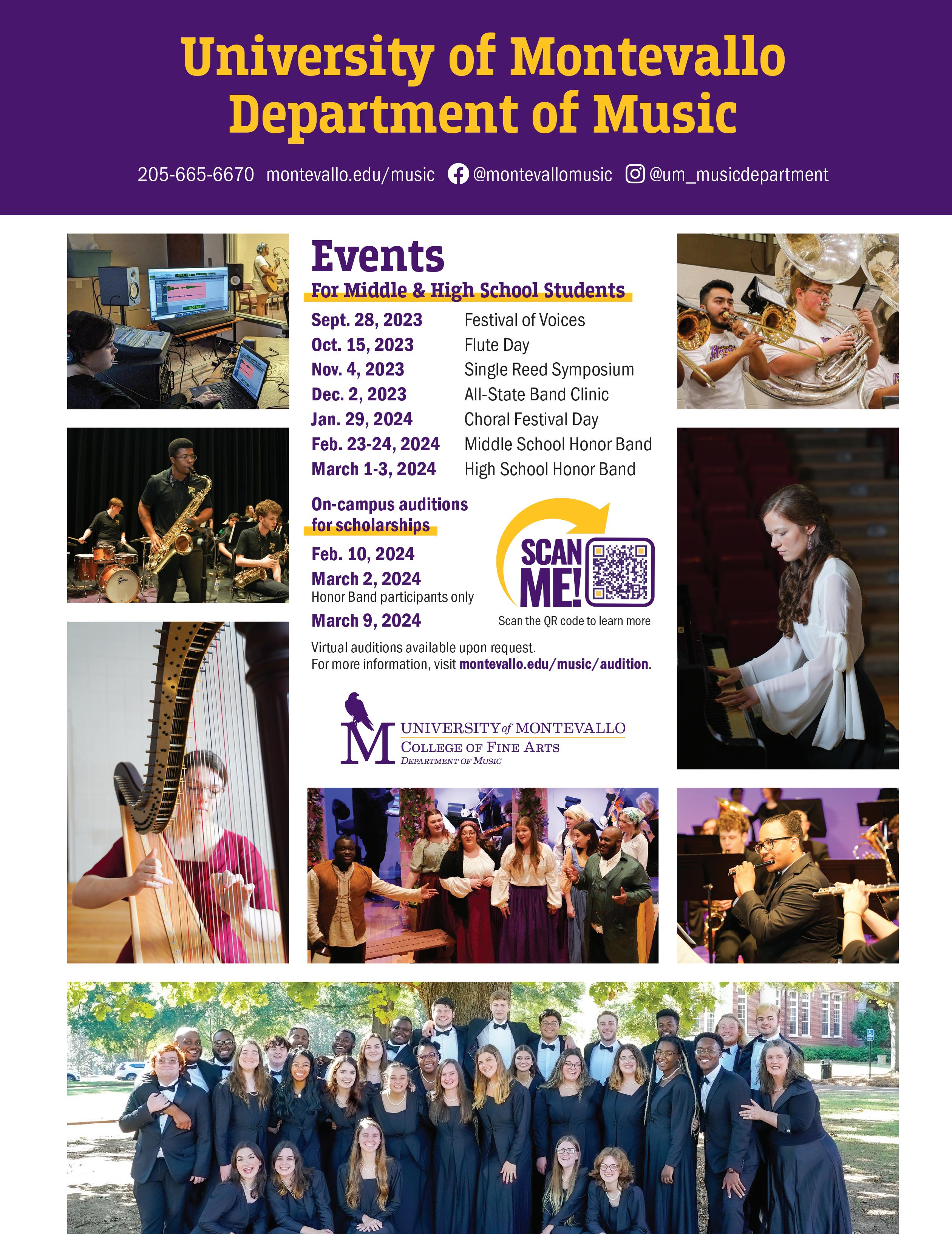

















































































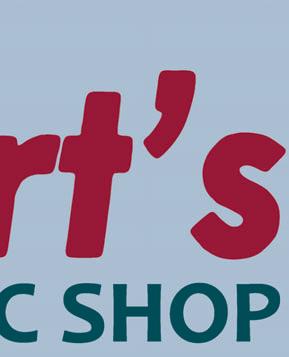



































































Montgomery 3030 East Blvd 334.271.2787 Dothan 1001 Commons Dr #2 334.793.1284 Birmingham 4647-O Hwy 280S 205.995.8376 800-341-2787 ArtsMusicShop.com









































 Director
Director












 AVA GOSPEL CHOIR
AVA GOSPEL CHOIR




































 CHARLES BROOKS, D.M.A.
CHARLES BROOKS, D.M.A.
















































 William Powell Director of Choral Activities Auburn University
William Powell Director of Choral Activities Auburn University










 Dr. Andy Nevala Director of Jazz Studies
Jacksonville State University
Dr. Andy Nevala Director of Jazz Studies
Jacksonville State University




 Garry Taylor Editor
Garry Taylor Editor


























































































































